

Monday, January 19, 2015
Budo begins and ends with rei.
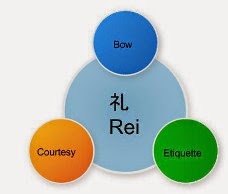
All above and more. In a dojo rei could be also the way of focusing your attention on what next will happen, helping you to leave outside what was outside dojo. You can't do a correct rei if your mind is wandering - especially in iai. When you bow to your sword, you acknowledge its presence and once sword in obi, you are ready to start using it. You are no longer a guy, you are a guy with a sword. It is an extension of your body that needs all the attention for a proper use. Since rei is done when alone too, beyond the social component, for me, has the meaning expressed above. The way you do rei will show what you think about the other person too. Let's not forget this. Rei is, at the end, a mirror of your spirit - you are cautious, will be seen. You trust the guy in front will show. You respect him will show. Etc etc etc. budo starts and ends with your attitude.
Post a Comment
- Feature articles
- Photo Gallery

Budo that have been well known in Japan since ancient times include judo, kendo, karate, kyudo, sumo, aikido, shorinji kempo, naginata halberds, and jukendo.They can be experienced at many places across Japan.
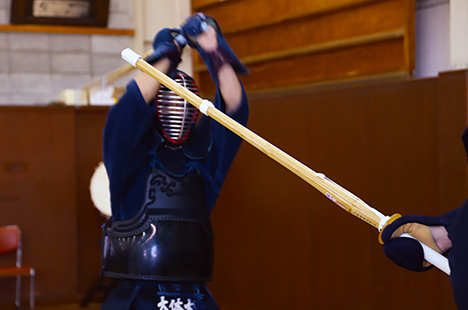
Budo refines your personality, enhances your morality, and respects civility. It is characterized by its ability to nurture the spirit in addition to martial techniques, and it is highly esteemed abroad as well.
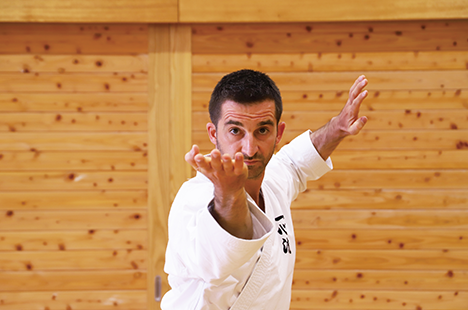
Together with the budo experience, you can enjoy sightseeing in the surrounding area. Through visiting picturesque spots and cultural and historical places, you can gain an increased sense of Japan.
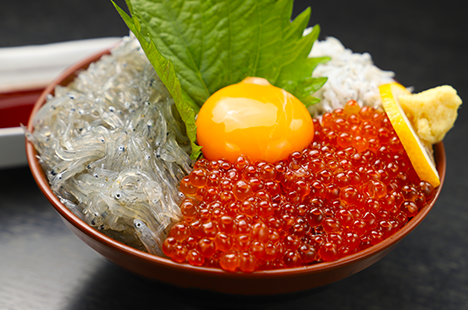
武士が戦う際の技である武芸の一つとして発展した柔術。その後、嘉納治五郎氏が柔術の様々な流派を研究し、明治15年(1882年)に東京・永昌寺の一角で「柔道」の道場を開きました。柔術は戦の場で使われていましたが、柔道は人を痛めつける技術ではなく、攻撃と防御の練習によって身体を鍛えて精神を磨き、互いに高め合うことができる武道です。技は大きく分けると2種類で、相手を投げる投技と、相手を抑え込む固技があります。投技で仰向きに倒したり、寝技をかけて制し続けたりすることで一本勝ちと判定されます。
- Tokyo/Bunbu Ichido Juku Shidokan
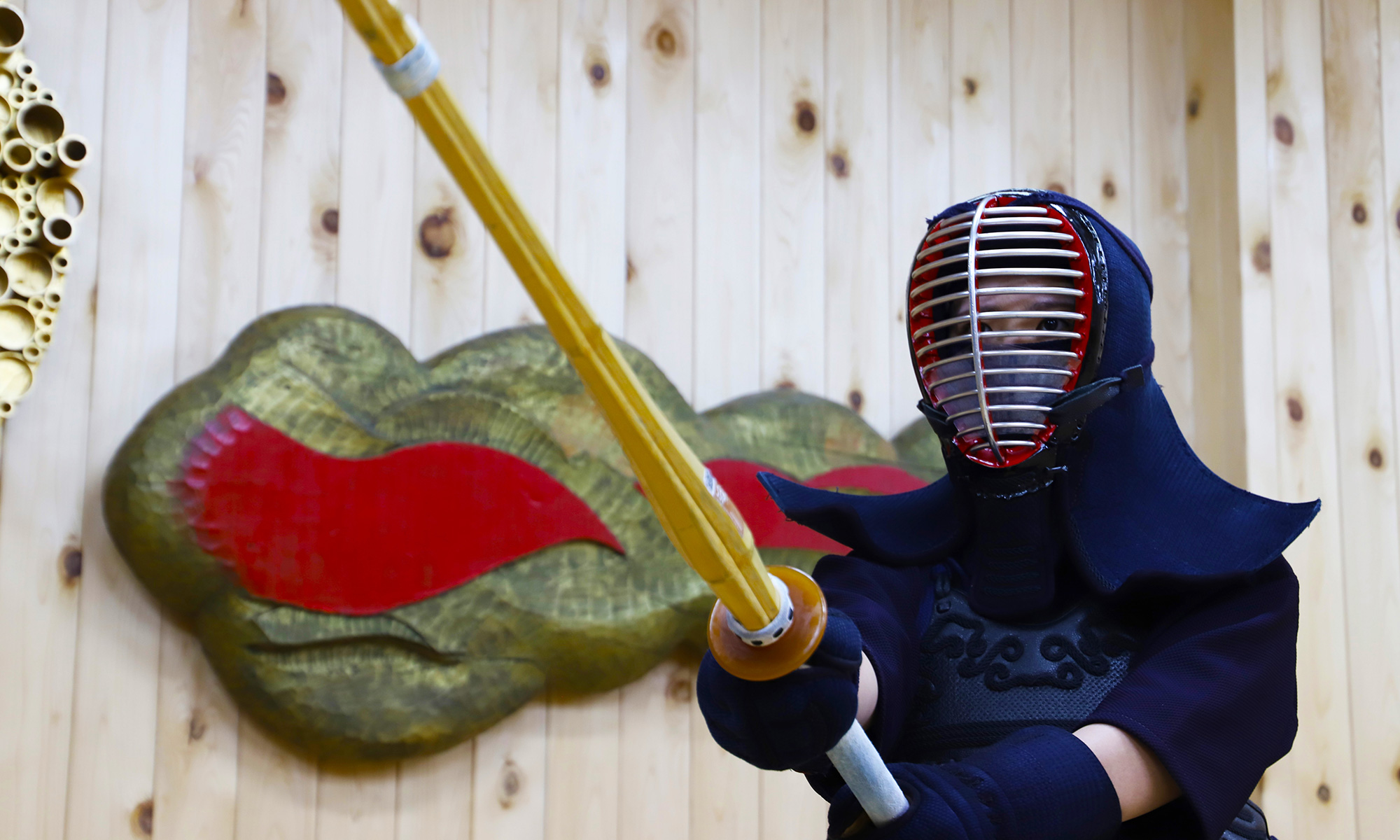
剣道は剣道具を着用して竹刀を用い、一対一で打突し合う競技です。剣の使い方を学んで修練していくことで、生涯にわたる人間形成の道を目指します。剣道の歴史は、日本刀が出現した平安時代(794~1192年)まで遡ります。以降、刀は武士の戦いにおける主要な武器として使われるとともに、剣術も磨かれていきました。江戸時代(1603〜1868年)の中頃には剣道具が開発され、竹刀によって行う剣術の稽古が定着。道場での剣術の試合も急速に広まっていき、武士の精神に基づく「武道」として発展していきました。
- Tokyo/SAMURAI TRIP
- Kyoto/WAK JAPAN
- Ishikawa/Learn about samurai culture and the spirit of bushido Kanazawa Budo Tourism Project
- Osaka/Osaka University of Health and Sport Sciences
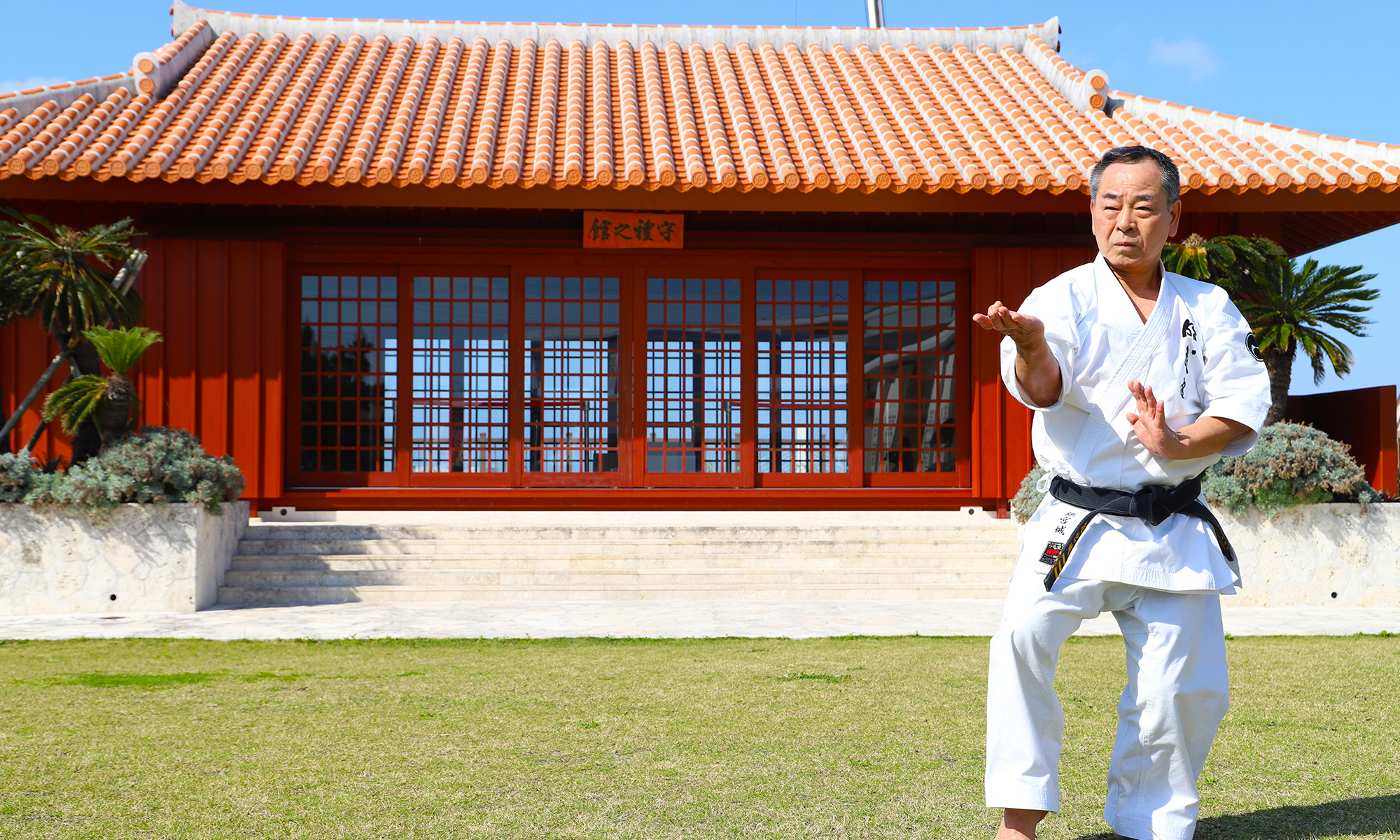
空手は琉球王国時代の沖縄を発祥とする格闘技で、沖縄在来の武術「ティ(手)」と、中国武術等が何世紀もかけて融合し、沖縄から世界へ広まっていきました(※諸説あり)。空手には大きく分けて「形」と「組手」があります。「形」は仮想の敵に対する攻撃技と防御技を一連の流れとして組み合わせた演武。動きがブレず、キレと迫力、流れの美しさが評価に繋がります。「組手」は8m四方の競技場の中で、突き・蹴り・打ちの3種の技を出しながら1対1で戦います。
- Okinawa/Okinawa Dento Karatedo Shinkokai
- Okinawa/Ageshio Japan
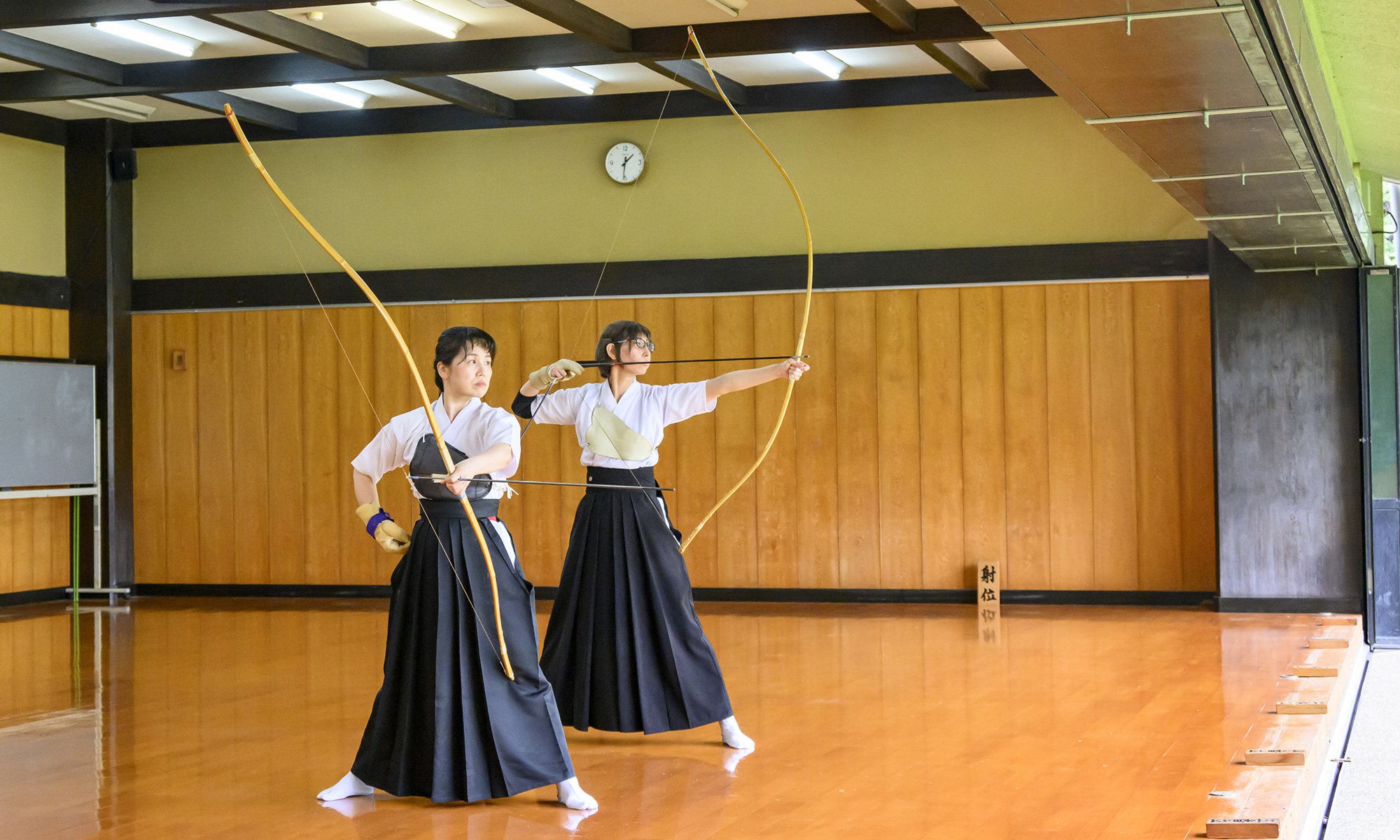
弓道は照準器のない弓で矢を飛ばして的を狙う武道です。弓道の歴史は古く、狩猟をしていた時代には世界中で弓が使われていて、旧石器時代末期には中近東アジア地方の民族も使用していました。日本では12世紀に馬に乗って弓を引く流鏑馬(やぶさめ)も盛んになりました。的を射るためには、正しい形や姿勢、平常心を保って射ることがポイントになります。加えて内面の人格的向上が一体となったとき、理想的な美しい弓が表現されます。
- Fukushima/Aizu Clan School Nisshinkan
- Ishikawa/Kanazawa Culture and Sports Commission
- Hiroshima/Kyudo Experience Dojo SHA-RAKU
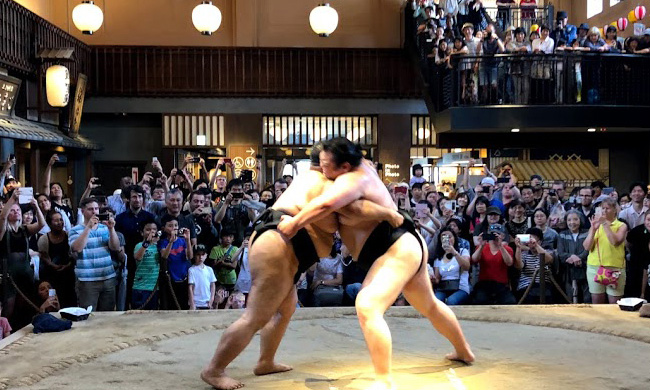
相撲は力比べや取っ組み合いから発生した日本の伝統的なスポーツです。相撲に似たスポーツは古くから世界各地で行われていましたが、日本では歴史書である『古事記』及び『日本書紀』に登場する力比べや天皇が観覧する天覧勝負の伝説が起源としてあげられます。現在のように頭にまげを結った力士が土俵に上がり、1対1で取り組みをするスタイルになったのは江戸時代(1603〜1868年)からと言われています。プロの力士による大相撲は、年に6回、15日間の取り組みが行われ、その成績によって番付が決まります。
- Tokyo/sumo experience.com
- Tokyo/Shimane/Arukikata
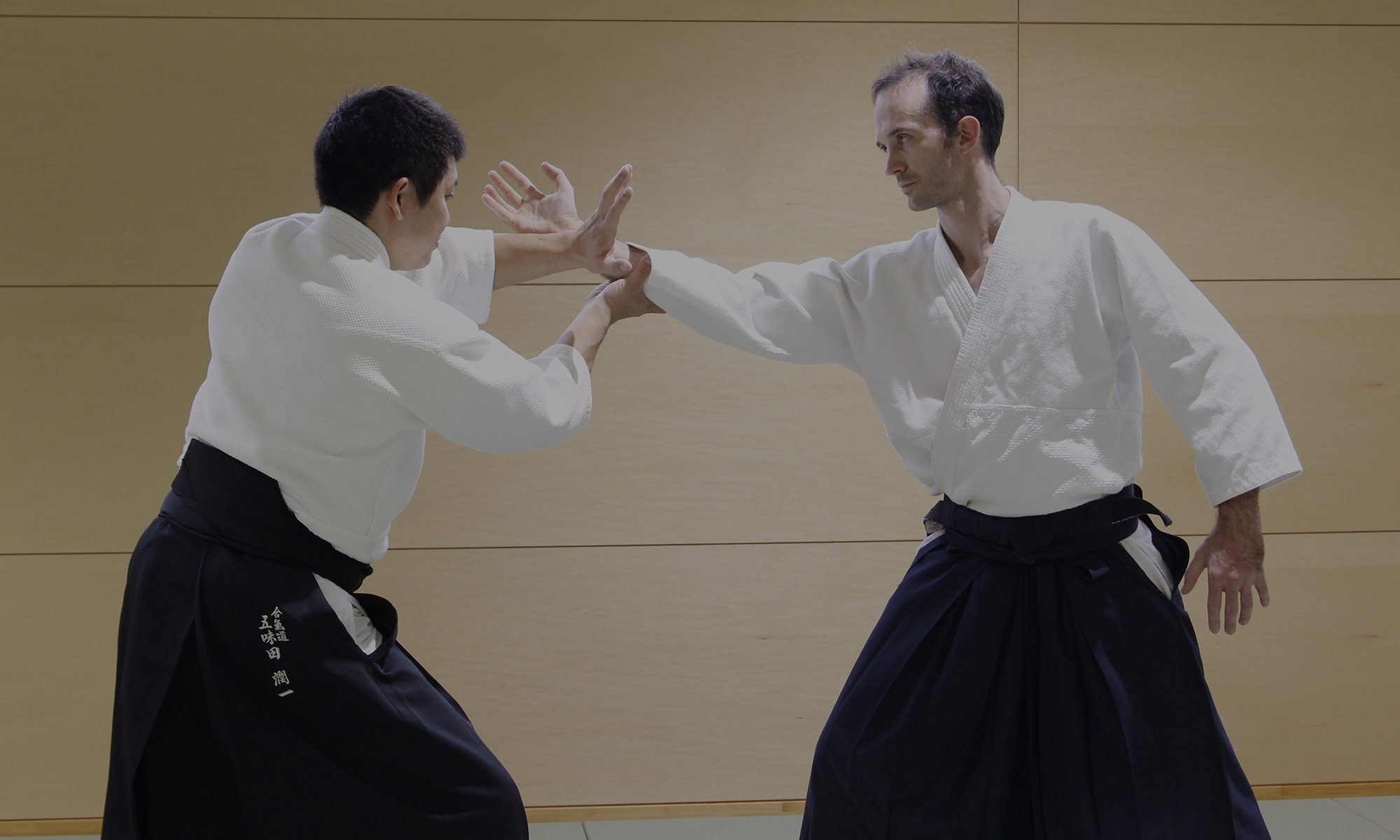
合気道は開祖である植芝盛平(うえしばもりへい)翁が日本伝統武術の研鑽を重ね、厳しい精神的修養を経て創始した現代武道です。合気道の基本となるのは「構え・武法」「座法」「体さばき」。そして呼吸力から生まれる技により、お互いに切磋琢磨し合いながら鍛錬を重ね、心身の錬成を図ることを目的としています。他人と優劣を競うことをせず、試合や競技を行わない点は、ほかのスポーツと大きく異なります。現在約140の国と地域で広まり、日本のみならず世界中に愛好家が多くいます。
- Kyoto/Aikido Aishinkan
- Wakayama/Tanabe City Kumano Tourism Bureau
Shorinji kempo
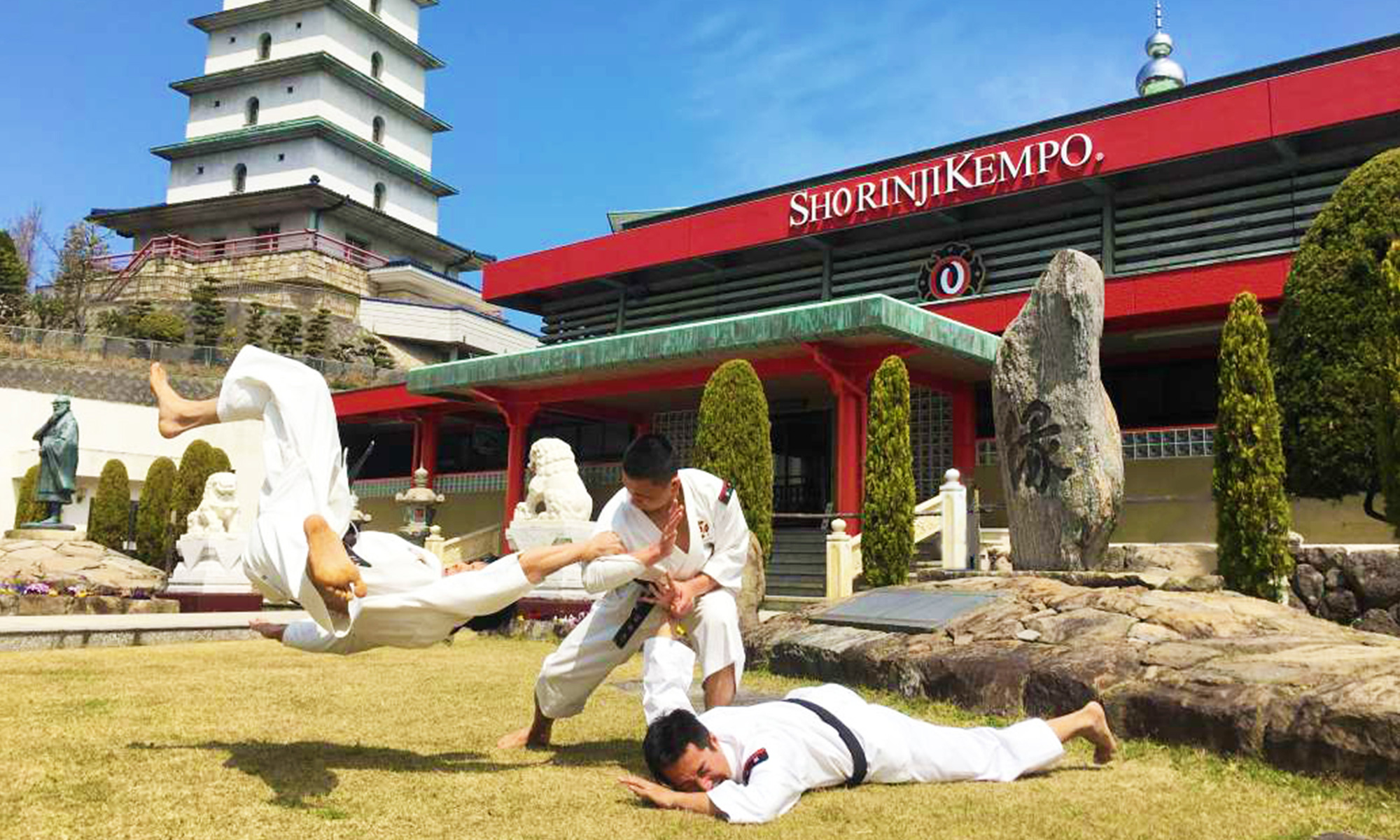
中国に渡って各種の拳技を修得した宗道臣(そうどうしん)氏は、第二次世界大戦後に「平和で物心ともに豊かな社会を作りたい」という想いから、香川県多度津町で教えたことが少林寺拳法の始まりです。「易筋行(えききんきょう)」という動作を主軸に、呼吸法や作務(掃除)などの修行を行い、体と心の両面をバランスよく修養します。また、勝ち負けを競ったり、人を傷つけたりする技法ではなく、自分や他人の身を守って活かすための護身術です。
- Kagawa/Kongo Zen Sohonzan Shorinji
Naginata halberds
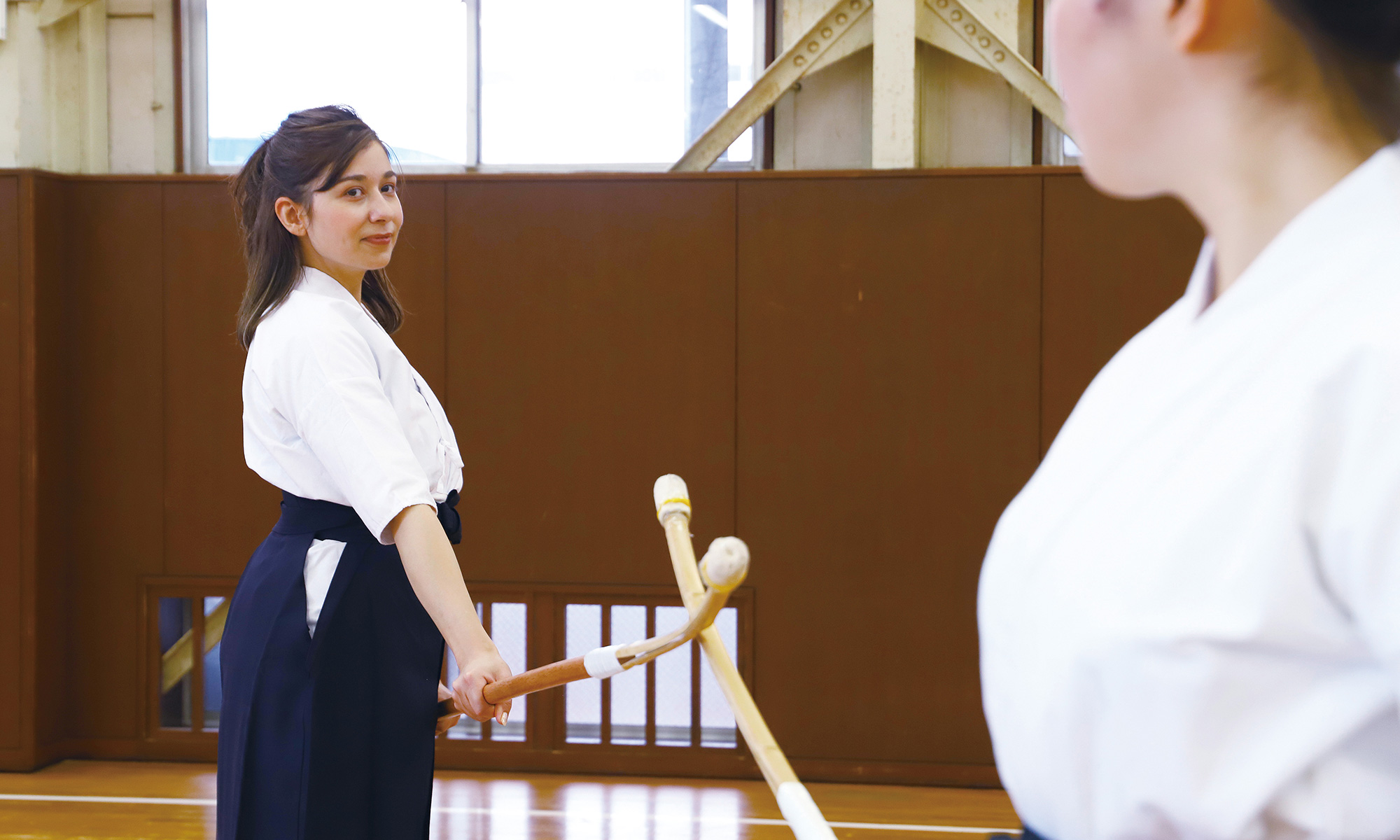
なぎなたは2m以上もある長物を武器として相手に打ち込む武道です。競技としては演技と試合の2つがあり、演技では防具を付けずに指定された形を2人1組の演技者によって行い、その技の優劣を競います。一方、試合では、2人の試合者が防具を身に付け、定められた部位を確実に早く打突して勝負を競います。起源は諸説ありますが、平安時代(794~1192年)に起こった承平・天慶の乱を描いた合戦絵巻や、源義家と奥州清原家との争乱を記した書物の中に「長刀」として登場しています。
- Hyogo/Syubukan
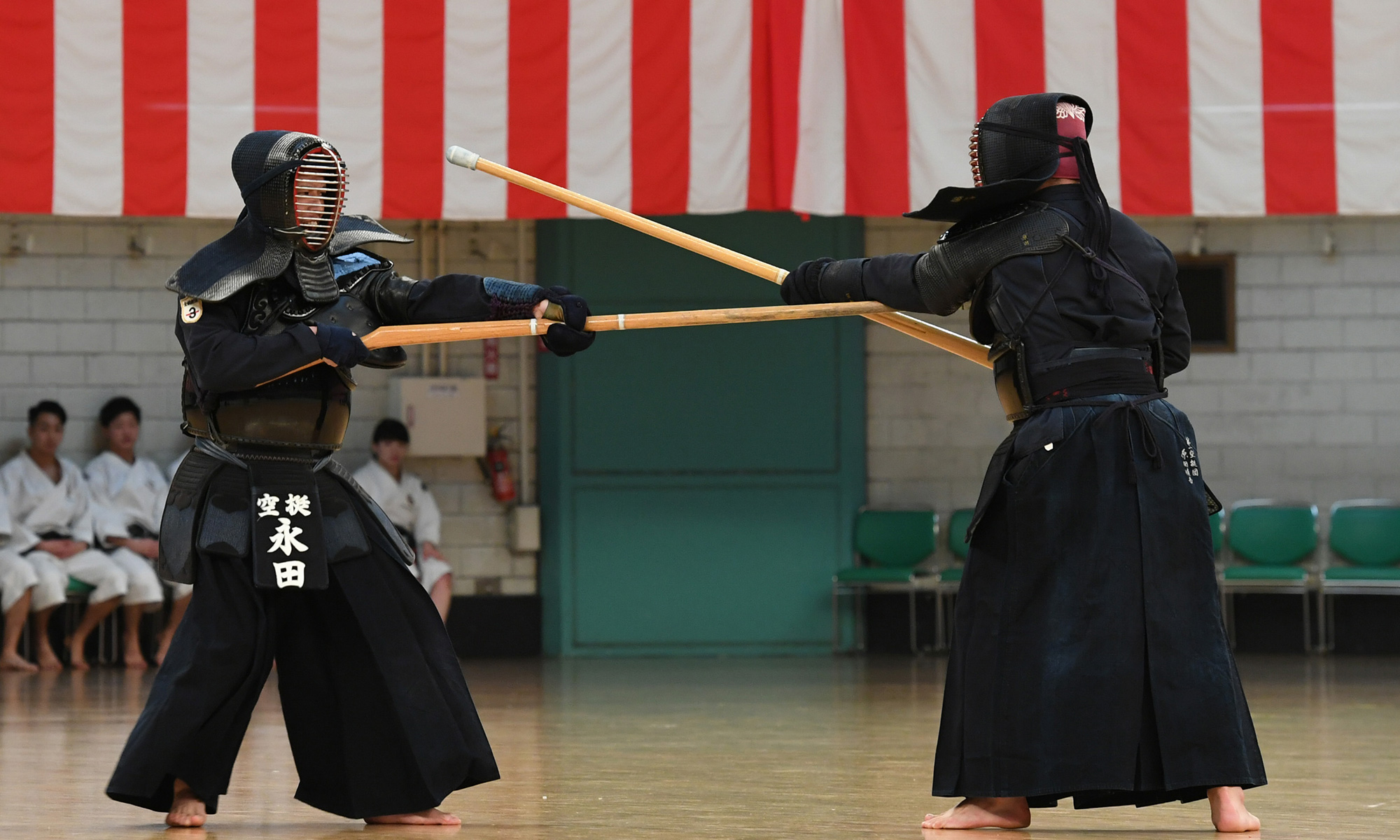
明治時代(1868〜1912年)初期に、槍術の「突き技」を基本として発展した銃剣道は、木銃を用いて相手の喉や胴等への突き技を競い合う競技です。木銃は樫の木で作られていて、中学生以上は長さ166cmと定められています。木銃の先にはタンポと呼ばれるゴムが付いていて、突き技の衝撃を和らげてくれます。また、剣道の防具と同じように面を付けて試合を行います。相手よりも早く左胸や喉を正しい姿勢で突くことで勝敗が決まります。
- All over Japan/All Japan Jukendo Federation
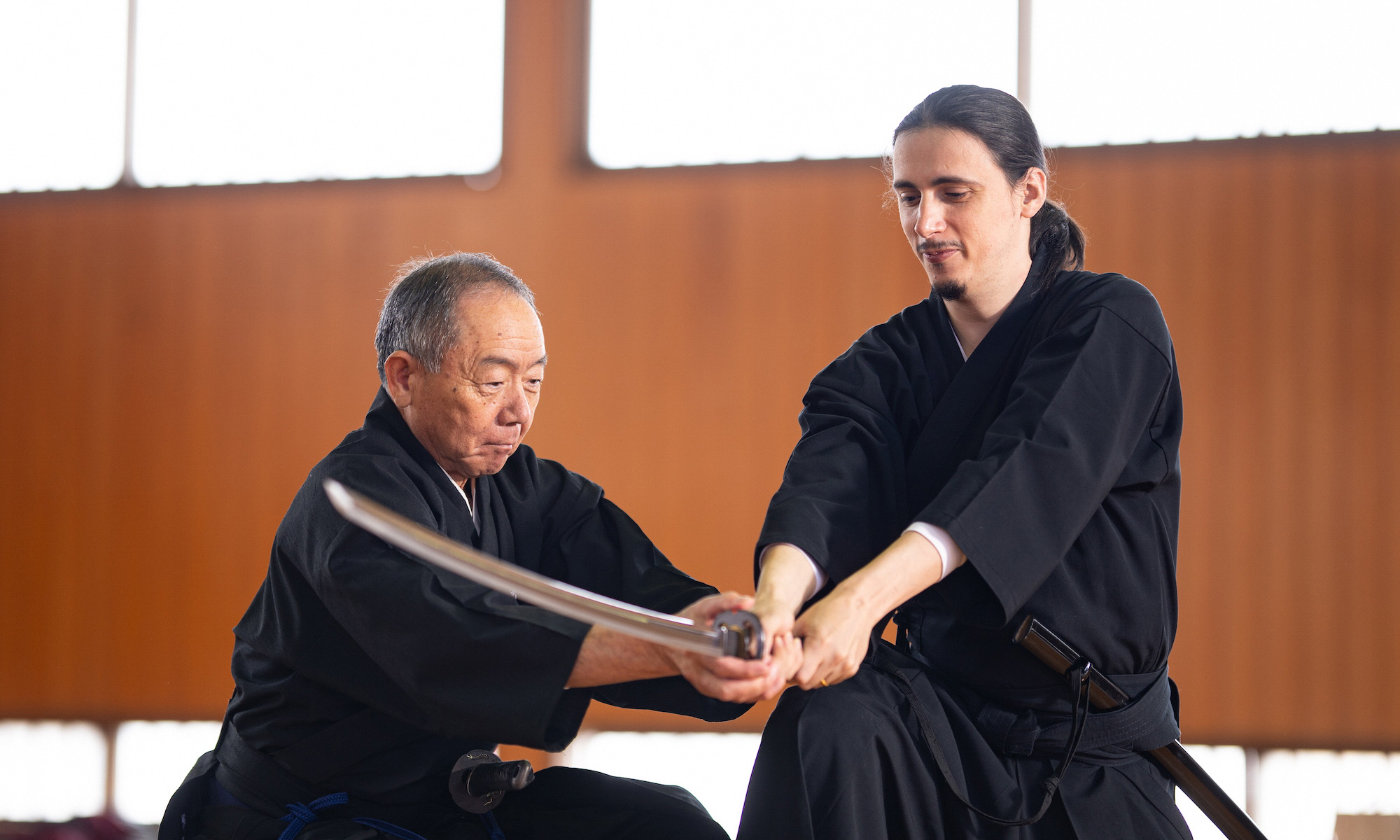
柔道、剣道、空手道、弓道、相撲、合気道、少林寺拳法、なぎなた、銃剣道のほかにも、日本には様々な武道があります。日本刀を使って集中力を高め抜刀の一瞬で勝負が決まる居合道、棒やヌンチャクなどを使って型を修練する沖縄古来の武器術・琉球古武道、走る馬上から弓矢で的を射る流鏑馬(やぶさめ)なども、日本の武道として親しまれています。本格的なものから気軽なものまで多種多様な武道体験が楽しめるところは日本国内に増えています。
- Yamagata/Murayama Iai Shinbukan(Iaido)
- Ibaraki/Japanese Traditional Mounted Archery Yabusame(Yabusame horseback archery)
- Tokyo/Toyama Bizenkai(Iaido)
- Tokyo/AYUMU OSHIRO's Martial Arts School(Samurai experience)
- Tokyo/Sword fight lesson SAMURAI’ve(Swordfight experience)
- Ishikawa/Learn about samurai culture and the spirit of bushido Kanazawa Budo Tourism Project(Swords)
- Kyoto/Waraku(Sword)
- Okinawa/FM Kumejima(Ryukyu Kobudo)
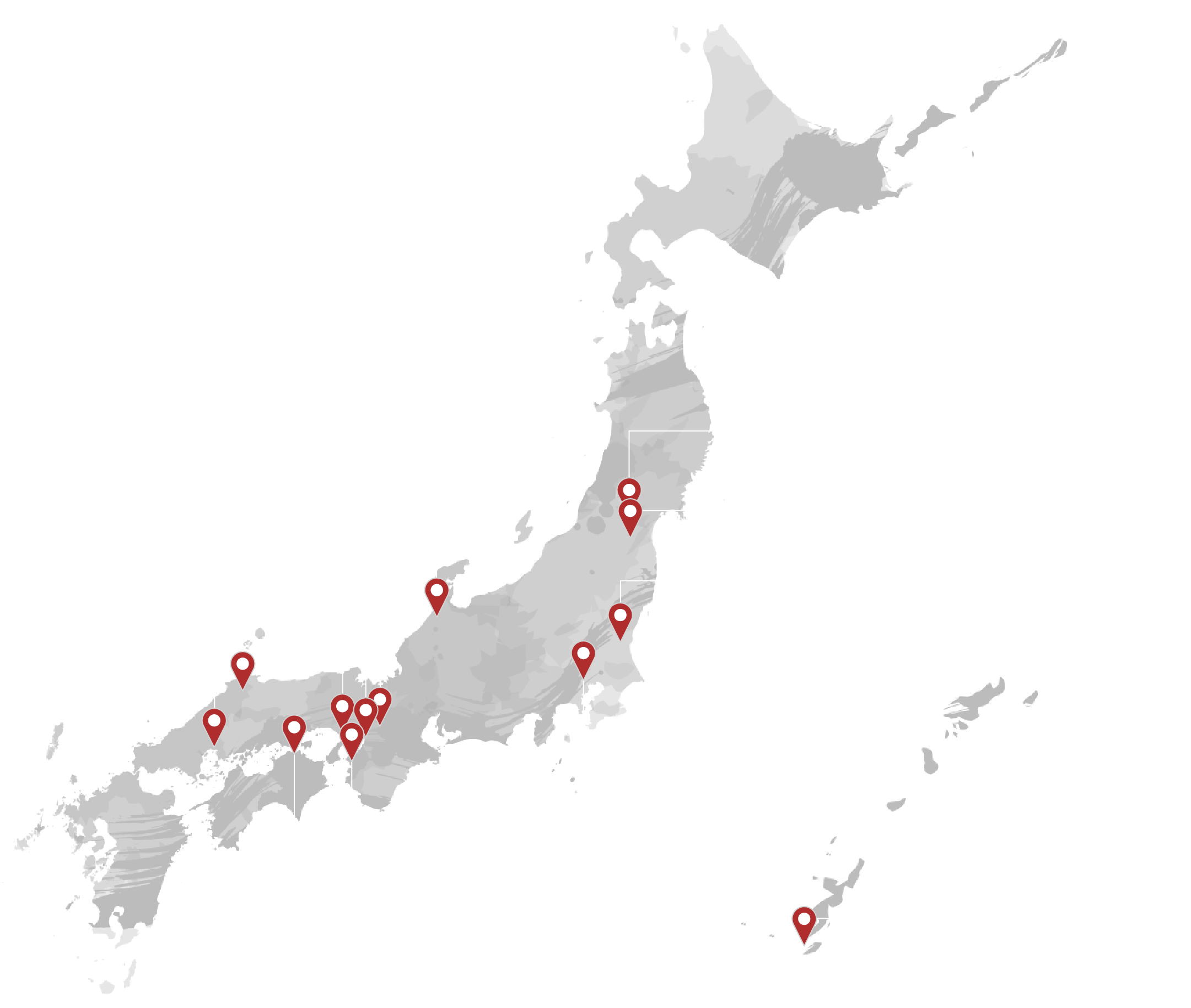
View 360 VR video from here
Murayama Iai Shinbukan
Iaido uses Japanese swords to train swordsmanship and spirit. Its founder, Hayashizaki Jinsuke Shigenobu, was born in 1542 in Hayashizaki village, Ushu Tateoka (the current Hayashizaki, Murayama City). The dojo adjacent to Iai Shrine (official name: Kumano Iai Ryo Shrine) offers Iaido experience programs. The trial cutting (shizan) experience is a popular program to learn the shape of Iaido and Shohatto from high grade instructors and cut a tatami-tube with real swords. In addition, demonstration and trial cutting tour programs are held. Powerful swordsmanship using real swords is a sight to see.
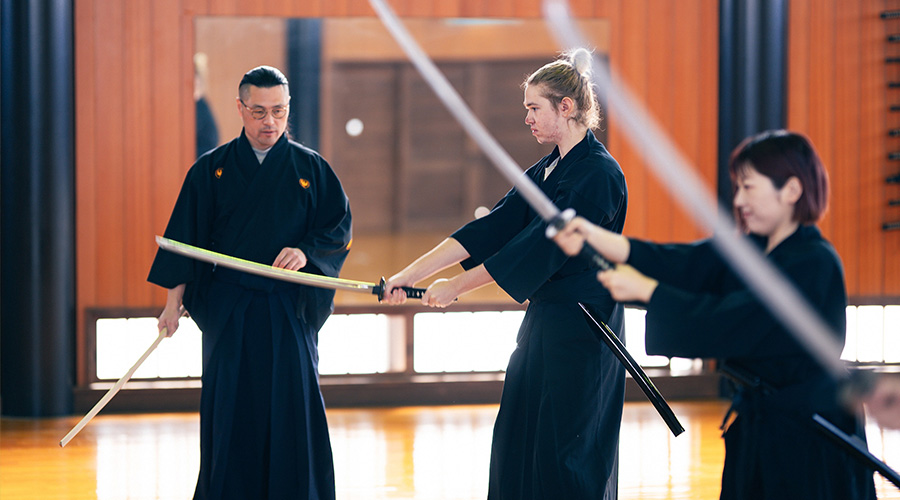
Sumo, which is closely related to Japanese traditional culture and spiritual culture, is a prestigious budo that has been handed down from Japanese mythology to the present day. The appearance of sumo wrestlers has not changed since the Edo period (1603-1868), and today many foreign wrestlers are also active, making sumo increasingly well-known abroad. If you participate in a program that visits the morning practice at sumo stables in Sumida City, Tokyo, which is a sacred place for sumo, or a program that visits Izumo City, Shimane Prefecture, the place where sumo is said to have originated, you will be able to experience the depth of sumo even more.
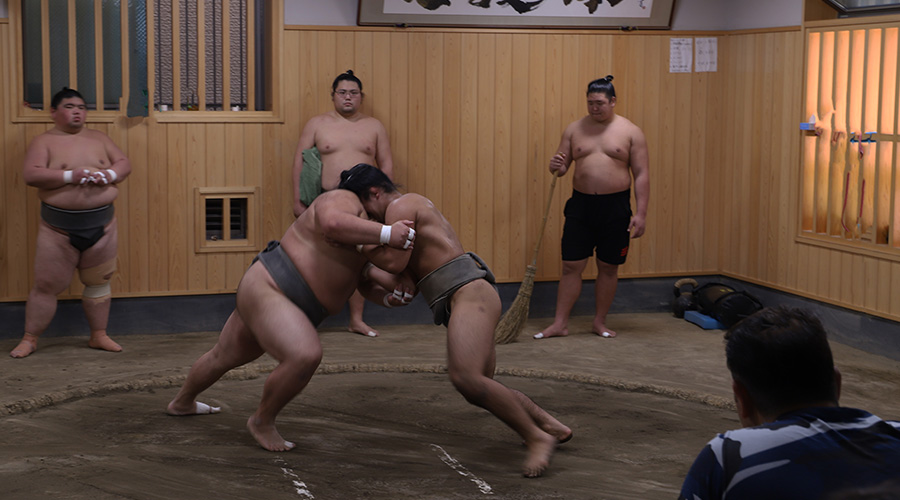
FM Kumejima
Ryukyu kobudo is an ancient Okinawan martial arts with weapons that uses sticks and nunchaku to practice kata (form). On Kume Island, where Shinken Taira, who is said to be a leading figure of Ryukyu kobudo, was born, you can actually experience kobudo. Kume Island, the entire island of which is also an Okinawa Prefectural Natural Park, is a beautiful remote island with many scenic spots. You can experience Ryukyu kobudo with nature at such a scenic spot, which is unique to Kume Island. The experience-based program with the view of the crystal clear ocean in the distance will heal you with every breath, and if you participate in the morning yoga program based on the same breathing theme, you can experience an even greater healing effect.
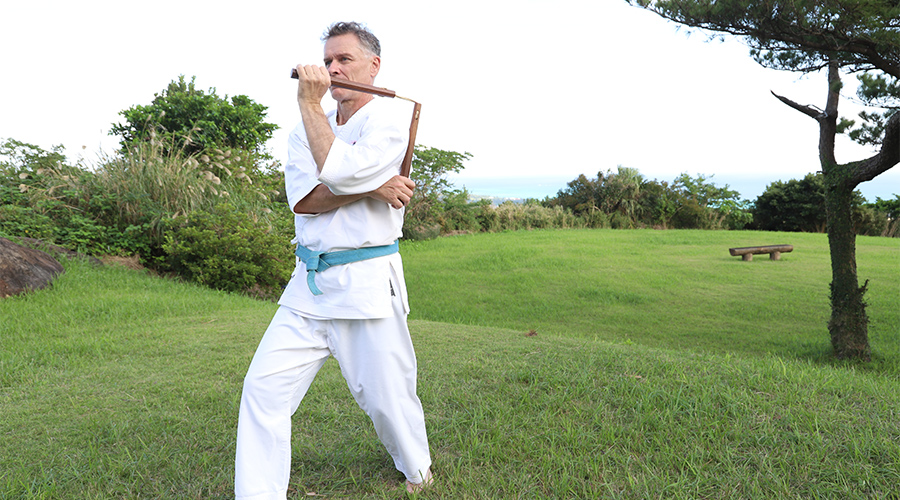
Learn about samurai culture and the spirit of bushido Kanazawa Budo Tourism Project
The Kaga domain, known as Kaga Hyakumangoku (Kaga 1 million koku) during the Edo period (1603-1868), was the second largest taihan (domains of feudal lords who were granted 10,000 koku or more by the shogun during the Edo period) after the Tokugawa shogunate family. Inheriting this history, Kanazawa still has crafts such as gold leaf and kaga yuzen, performing arts such as noh and geiko culture, and samurai culture such as the tea ceremony and other traditional arts, and various budo can also be experienced. With the full cooperation of the Ishikawa Prefecture Kyudo Federation, you can experience kyudo while wearing hakama at the authentic kyudo hall that is also used in tournaments. You can experience kendo with guidance from a 7th dan kendo master and see the swords actually possessed by samurai.
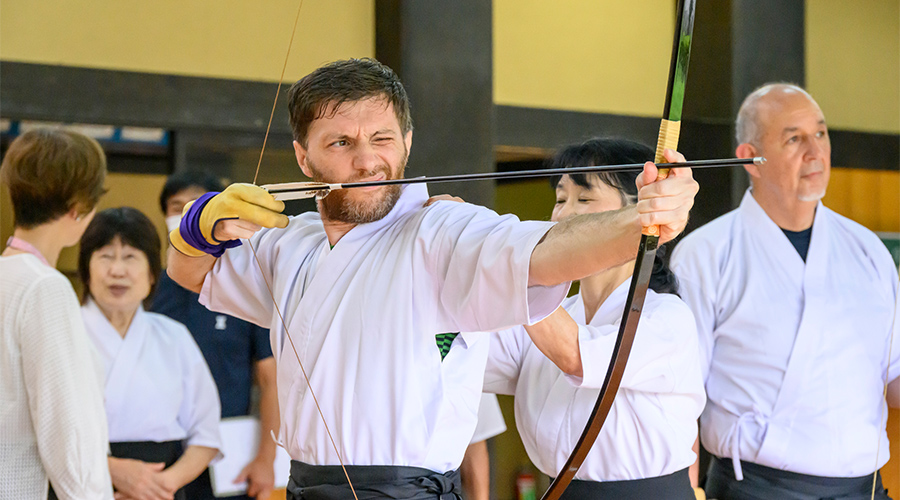
Tanabe City Kumano Tourism Bureau
Aikido is a modern budo that was founded by Morihei Ueshiba, who studied traditional Japanese martial arts and then went on to establish aikido through rigorous spiritual training. Popular in about 140 countries and regions, it now has many fans not only in Japan but all over the world. In aikido, practitioners practice together regardless of age, gender, and so on, and do not compete with each other. In the practice, uke (who applies the technique) and tori (who receives the technique) train their mind and body by exchanging techniques. In Tanabe City, Wakayama Prefecture, where Morihei Ueshiba, the founder of aikido, was born and raised, you can experience aikido under easy-to-understand guidance.
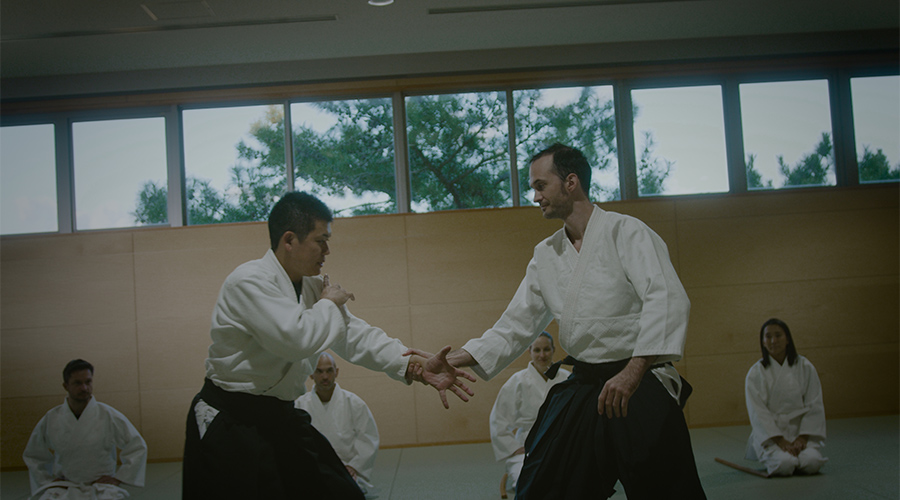
Okinawa Dento Karatedo Shinkokai
Karate has been developed over centuries as a unique budo fusing the traditional Okinawan art of te with Chinese budo, etc. (*There are various theories.) It later spread around the world, and today there are more than 130 million karate aficionados worldwide. The four main schools of contemporary Okinawa Karate are Shorin Ryu, Goju Ryu, Uechi Ryu, and classical budo using weapons such as poles, nunchakus, and sai. Many travelers from around the world take part in the wide range of training programs available, including not only regular evening training in the dojo but also morning training and introductions to the four main schools of Okinawa Karate.
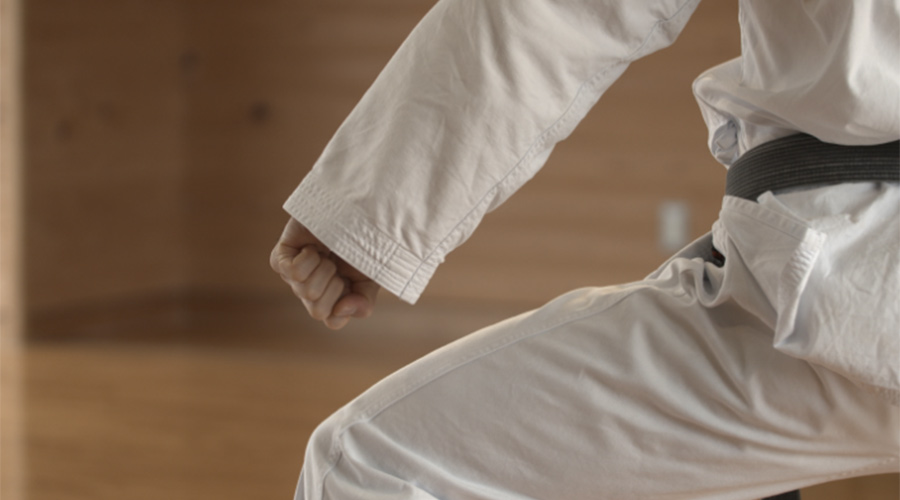
Osaka University of Health and Sport Sciences
Budo respects the personality of others and values manners to nurture spiritually rich human beings. The kendo club and naginata club of Osaka University of Health and Sport Sciences have contributed to continuing and developing the tradition and the spiritual culture for more than 50 years since their foundation. Moreover, the Sennan area of Osaka Prefecture, where the university is located, is an attractive area with a traditional festival and hot springs as well as history, culture, and industrial resources. Enjoy the BUDO experience of pretending to be the fencer with other student fencers or participate in an advanced-level lesson, depending on your goal, under the guidance of specialized instructors while sightseeing the attractive Senshu area.
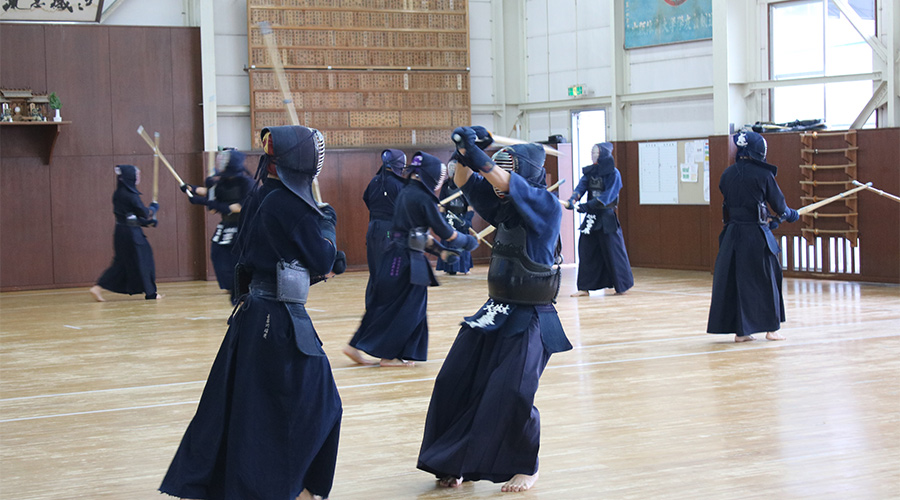
sumo experience.com
Sumo is a sport that respects the courtesy of beginning and ending with rei. Sumo wrestlers' actions also have various meanings. Showing their palms with extended hands wide to the right and left is said to convey to the opponent that they will compete fairly and squarely without weapons, and the sprinkling of salt is said to purify evil spirits. An experience program to convey the essence of sumo accurately and honestly to overseas visitors is available. The program focuses on that sumo has aspects of competition as well as traditional culture as a Shinto ritual. You can experience the charm of prestigious sumo.
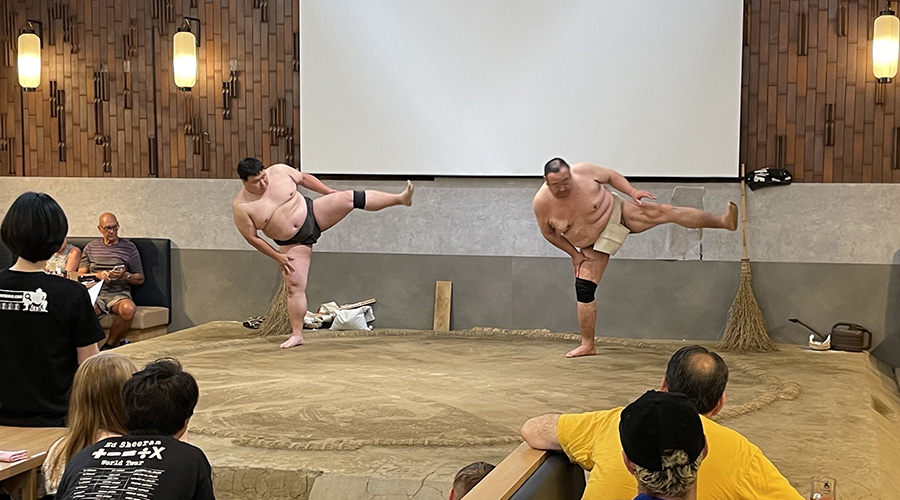
True Japan Tour
Practice the fundamentals and experience real Kumite (sparring). You can definitely learn authentic karate from karate instructors!
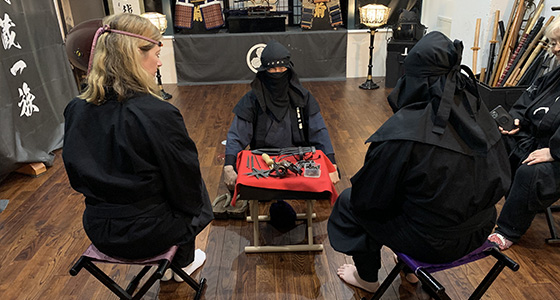
Musashi Ninja Clan
Experience ninja and samurai with Musashi Ninja Clan, which has passed down the tradition of ninja martial arts and crafts!
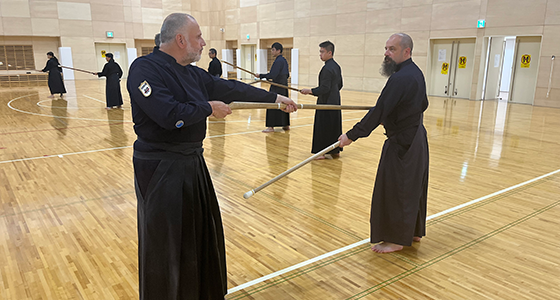
All Japan Jukendo Federation
You can experience Jukendo at training sessions held in various locations around Japan!
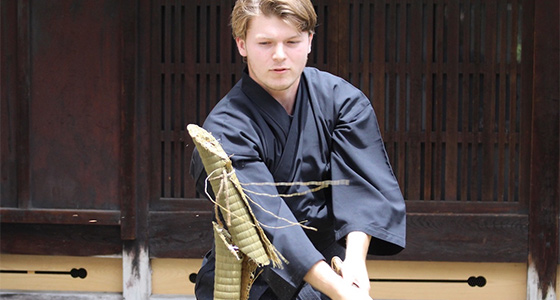
The sword and Zen is the theme. In an approximately 250-year-old samurai residence you can touch a real Japanese sword and experience Zen meditation
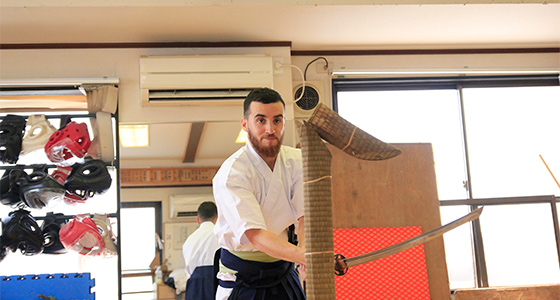
Toyama Bizenkai
A popular option is the samurai experience of the three disciplines of kenjutsu (iai, gekken, tameshigiri) comprehensive course
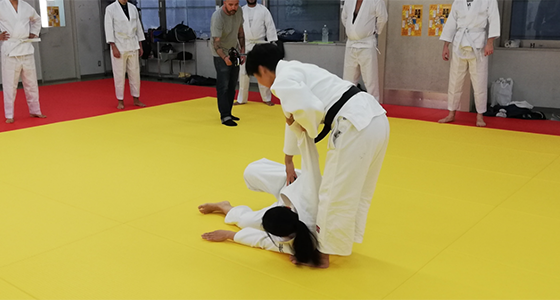
Bunbu Ichido Juku Shidokan
Learn about the history and philosophy of judo, while experiencing falling and throwing techniques
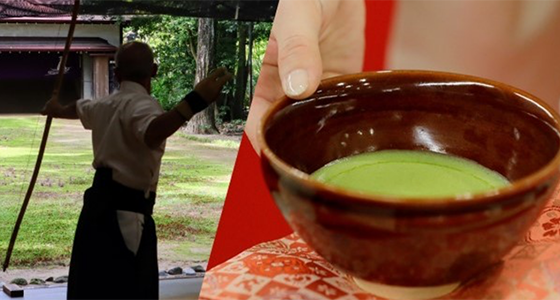
Kanazawa Culture and Sports Commission
Experience Japanese archery & Culture
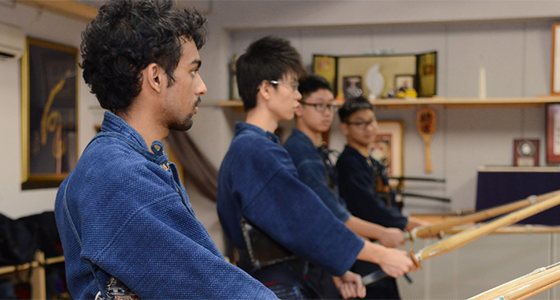
SAMURAI TRIP
Experience the skills and spirit of the samurai on this authentic kendo tour
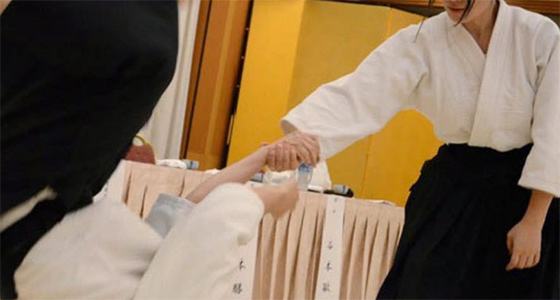
Aikido Aishinkan
Enjoy a safe aikido experience at a dedicated dojo in Kyoto
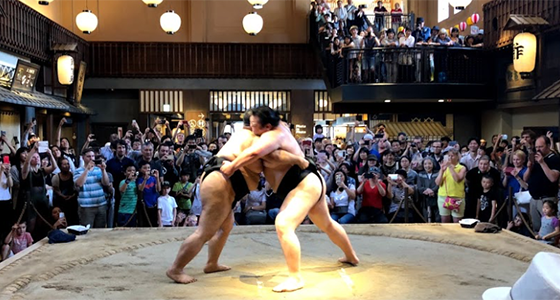
Sumo wrestling demonstration, technique introduction, lectures and practice guidance by former sumo wrestlers.
-3.jpg)
Experience the world of a samurai in Murayama City,Yamagata, the birthplace of iaido
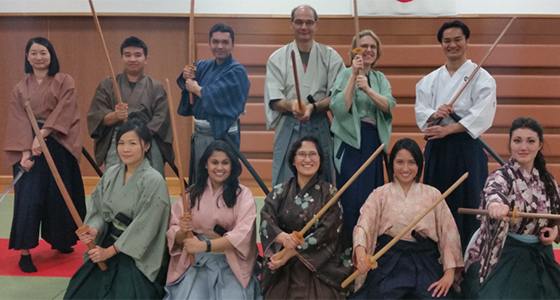
AYUMU OSHIRO's Martial Arts School
A program that conveys the culture and spirit of the samurai
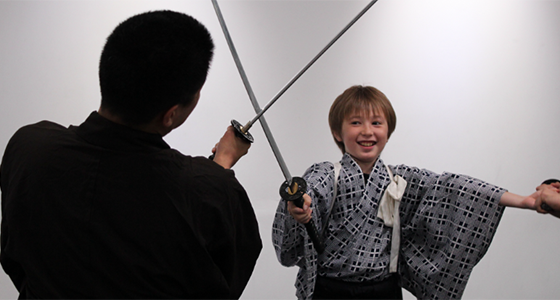
Sword fight lesson SAMURAI’ve
Experience the thrill of sword fighting as a samurai
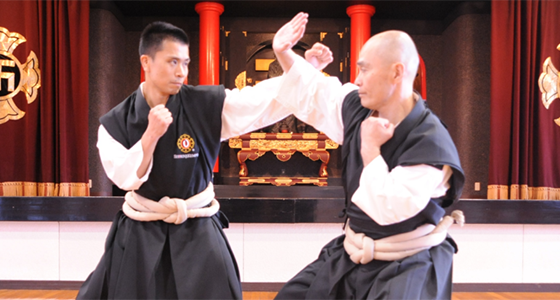
Kongo Zen Sohonzan Shorinji
A spiritual journey to physical and mental training at the head temple of Shorinji Kempo, Shumon no Gyo(discipline of the sect) *Japanese only
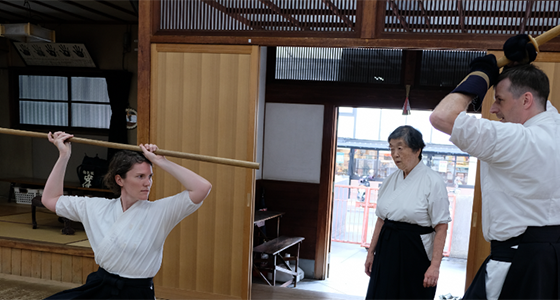
Experience a traditional Japanese budo in a dojo that has been in operation since the Edo Period *Japanese only
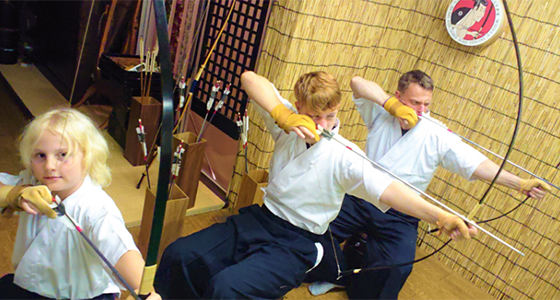
Kyudo Experience Dojo SHA-RAKU
An authentic kyudo experience for young and old alike
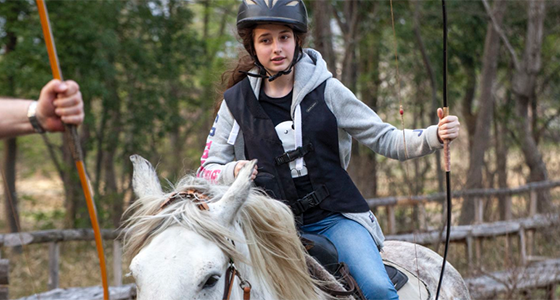
Japanese Traditional Mounted Archery Yabusame
Learn yabusame in Ibaraki, just two hours from central Tokyo
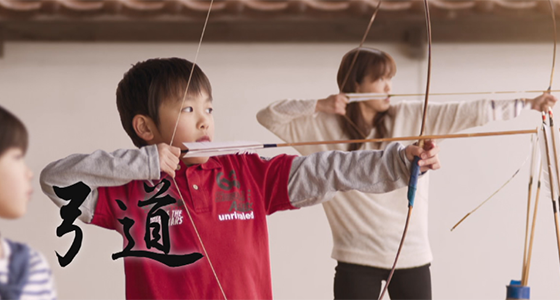
Aizu Clan School Nisshinkan
An easy kyudo experience for all, using small shihankyu bows *Japanese only
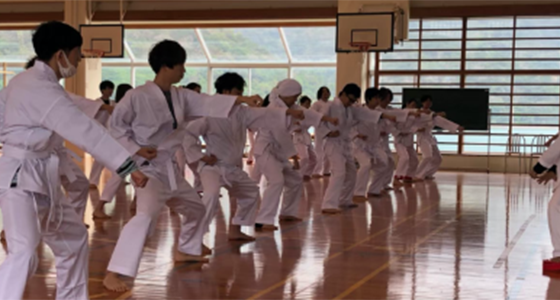
Ageshio Japan
Karate lessons for tour groups in Okinawa, the birthplace of karate
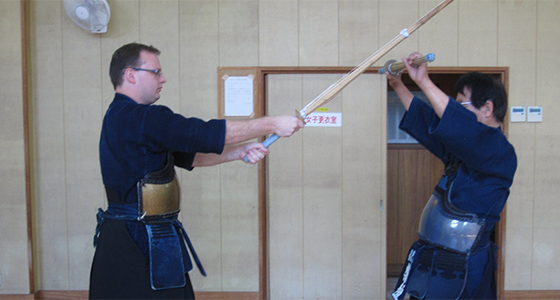
Experience kendo led by a highly experienced trainer in dojo (kendo training hall) and practice space.

"Mindfulness" and Kihon
Retaining focus on the basics
#budotraining #kihon #meditation #mindfulness #wellbeing
It seems like you can’t hit a wellness-themed feed on social media these days without being forcibly told that you need to be more "mindful", and there is merit in the mantra. Way back in 2014, Helen Langer, a Professor of Psychology at Harvard University gave an interview to Harvard Business Review in which she gave one of the most succinct, yet accurate, accounts of what "mindfulness" actually is. Langer said, “Mindfulness is the process of actively noticing new things. When you do that, it puts you in the present. It makes you more sensitive to context and perspective. It’s the essence of engagement”. She goes on to say, “We all seek stability. We want to hold things still, thinking that if we do, we can control them. But since everything is always changing, that doesn’t work. Actually, it causes you to lose control.”.
There is now a wealth of empirical research that demonstrates that mindfulness can improve memory and learning, as well as reducing stress, increasing creativity, and all of the other well espoused virtues. However, clearly, it is not always easy to by mindful doing everyday things, with all of the pressures and distractions of the day pulling at our attention. The same can sometimes be true when it comes to our Budo study. When we are doing things that we are familiar with, we tend to find our way to auto-pilot. How many times, for example, have you found yourself having to bring your mind back to the task in hand during, say, stretching exercises, or while rehearsing a solo kata that you are thoroughly familiar with.
Humans are built to be progressive. We learn through experience, lock-in that learning, and then move on to the next thing. This is usually a good thing - it is how we grow and develop. However, the unintended consequence of this is the parallel tendency for us to free up mental space by quickly assessing our new experiences, assimilating them, and then categorising and prioritising them. This is why, for example, when you view a prospective new house or apartment for the first time you notice all of those exciting details: layout, features, colours, and smells, but after you have lived in it for a while all of those vibrant initial elements start to fade into the background. They are simply overtaken by the “new noise” of daily life. The corollary in Budo is that the very same practice and constant repetition that we use to build our core skills, and then hone them, inevitably draws us away from being alert, in the moment, to their inherent richness.
It is possible to intercept the mind’s wanderings; not just in pursuit of being more mindful, but to also rediscover the brilliance in our kihon which, in turn, helps to create an even deeper understanding. Consciously choosing to not go through the motions is the first step. Think of it in terms of how you would prepare one of your daily meals: if you are in a rush and are eating purely for sustenance in order to get onto your next daily task, you will be much more likely to just grab something quick to prepare, consume it and move on with your day (with the additional downside that, food-wise, convenience, more often than not, equals less healthy). Contrast this with the experience of mindfully creating a meal that you have put some prior thought into preparing, by hand, with freshly sourced ingredients. Not only are you likely to produce a meal that is specifically to your individual taste, which you are likely to enjoy more than something produced for the masses from the supermarket shelf, but you get to experience the art of creating, the textures found in preparation, and the sensory uplift of the subsequent glorious smells of cooking. It might be slightly less convenient this way but at a fundamental level, as well as probably being more wholesome, it will always be more rewarding and more pleasurable.
The same approach can be taken in Budo practice of every kind. You can choose to "consciously" go through the motions. By this, I don’t mean simply focusing on what you are doing (I expect many practitioners, even in “non-mindful” Budo practice will still find themselves correcting their mistakes, or keeping in mind correct balance and proper form) but, rather, take in the whole picture. Mentally consider: Can you feel your body from within, what do your muscles feel like, where is your balance, do you feel hot or cold, what are your other senses telling you, are you using proper visualisation methods, and so on. Additionally, find ways to introduce some planned difficulty to something you would normally do without thinking.
Yes, progress and progressiveness is important, but it should never be at the expense of losing sight of the value and virtues contained within the basics of Budo arts. “Mindfulness” might be relatively new in buzzword terms but it has been present in Budo for a very long time and remains one of the very best disciplines to adopt as a daily, and training, way of being.
Share Budo Etc. Thought Leadership on

Celebrate progress!

Bunbu Ryōdō 文武両道

Embracing the Hobby Spirit

Gunshū Dasshutsu (群集脱出) Escaping crowds, mobs, rabbles and riots.

Affirmations and Budo


The Ten Elements of Kata (型 (or 形))

When Ganbatte (頑張って) isn’t enough

Micro-Train To Improve Your Budo

So You Don't Want To Teach Anymore...

Know Your Personality Flaws
Stay in touch with us on social media and find out more about what we do.
© 2024 Budo etc .
All Rights Reserve d
Budo Etc. is a trading name of Ikigaisystem Limited, registered in England and Wales
(Company no. 12546407)
Customer support: [email protected]
Tel: +447502270388
Navigation Menu
Search code, repositories, users, issues, pull requests..., provide feedback.
We read every piece of feedback, and take your input very seriously.
Saved searches
Use saved searches to filter your results more quickly.
To see all available qualifiers, see our documentation .
- Notifications You must be signed in to change notification settings
A mdBook template for Bujinkan practitioners
varjolintu/mdBook-bujinkan-template
Folders and files, repository files navigation, mdbook-bujinkan-template.
A mdBook template for Bujinkan practitioners.
The names and kata listings are from a great webpage wanderings in budo with some additions of my own.
Please see mdBook install instructions and Basic writing and formatting syntax by GitHub.
You can edit the src/SUMMARY.md if you want to change or edit any chapters of the text.
Basically, when you are done with your updates, build the book with mdbook build and you can open book/index.html locally or upload the page to your server.

Information, articles and videos about traditional Japanese martial-arts. Produced by BAB JAPAN, Tokyo About us WRITERS WANTED
The 46th Japan Cup Karatedo Championships: Yes, “sport” karate. So?
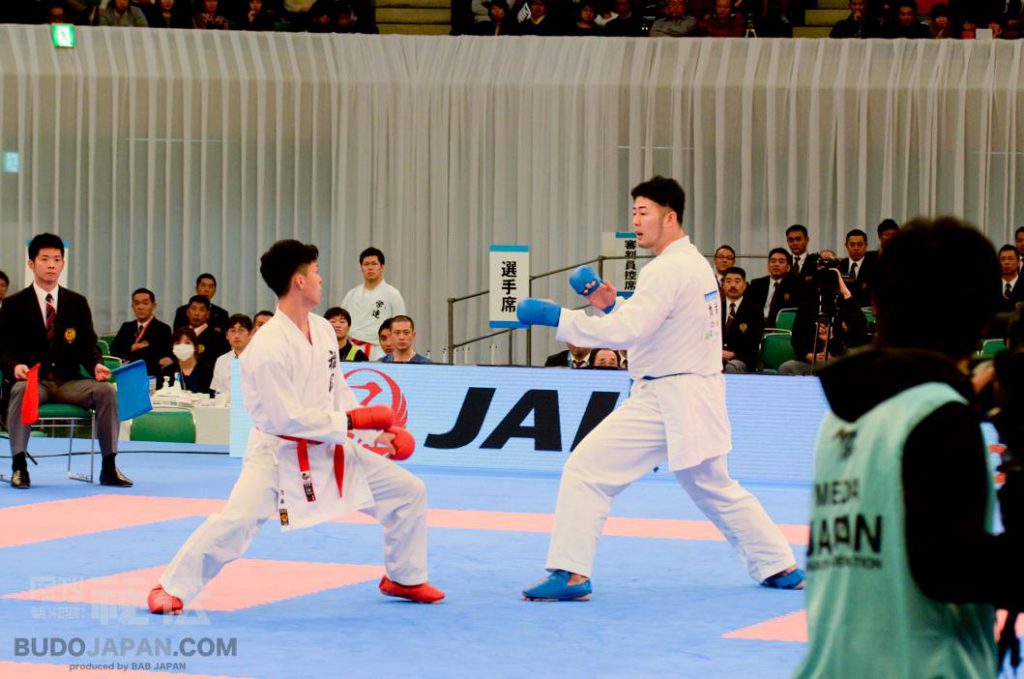
My problem with sports, cont’d
It’s been only a few months since I wrote, in my story about the 3rd World Kyudo Taikai and the seminar that went with it (Issue 7, July 2018) that I’m not particularly fond of sports and that one of the things that drew me to to classic martial arts was that they don’t involve competition. To explain myself a little further, it isn’t that I don’t like exercise –I do! It is that I don’t understand the rationale of sports: two people or teams play a game and one wins and the other loses. And? What does that mean? The winner gets some recognition of their win which is temporary since on a next match they will probably lose and they get happy because -what? They won? What did they win, exactly?
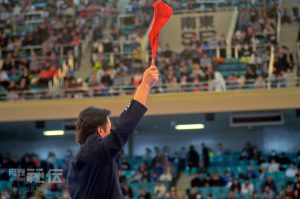
The 46th Japan Cup Karatedo Championships
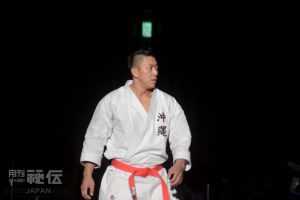
Kumite…
First the kumite -and this is for both men and women: the rules of the World Karate Federation say that scores can be ippon, waza-ari or yuko (three, two and one point, respectively) and for any score to be awarded, the technique needs to be performed with “good form”, “sporting attitude”, “vigorous application”, “awareness (zanshin)”, “good timing” and “correct distance” on the designated targets (head, face, neck, abdomen, chest, back, and side). But, for an ippon the player needs either a jodan kick (i.e. kick to the face) or a scoring technique on a fallen opponent and for a waza-ari, they need a chudan kick -punches and strikes (tsuki and uchi) only get yuko, that is just one point.
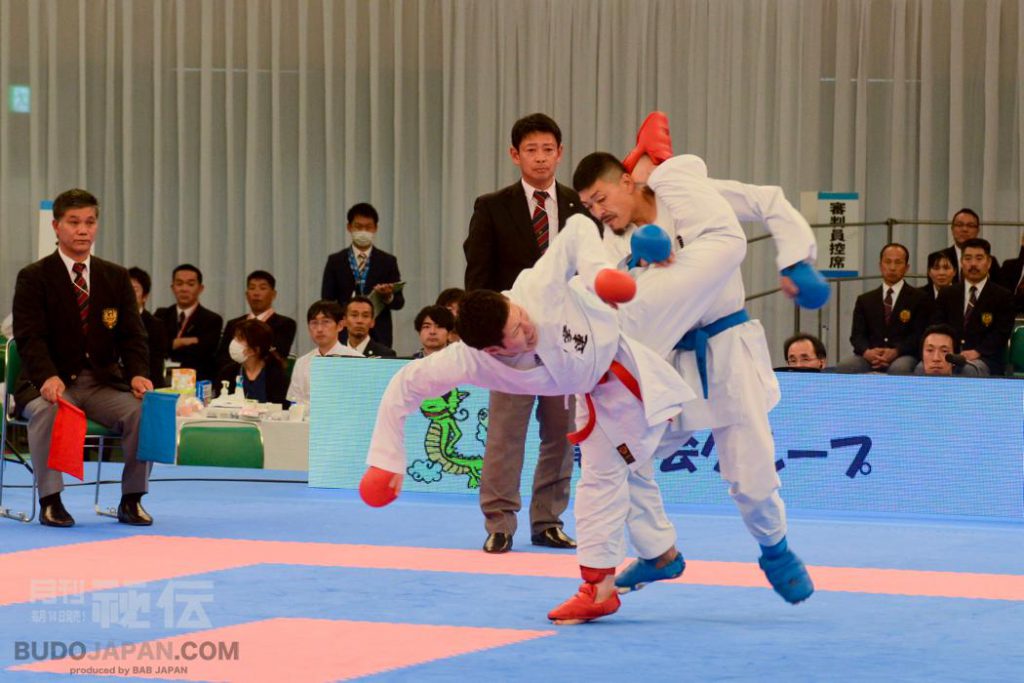
Just to avoid any misunderstandings, I don’t have anything against Taekwondo! Judged on its own merits, it’s an exciting sport (yes, I don’t like sports but let’s put that aside for a moment!) and I have met several very serious martial artists who started their journey with it –and a couple who stayed on it until the end. But if we want Taekwondo we already have one: karate has its own legacy and one that goes back centuries and spreads over many different traditions in two different cultures, that of the islands of Okinawa and that of main Japan. In my eyes, the karate of the 46th Japan Cup Karatedo Championships was not as much representative of this legacy as I would like; in other words, its look was closer to Taekwondo than to the karate I knew over 30 years ago.
I had similar issues with the kata, again both in men and women: the players can choose from a set of 102 kata from the four styles that comprise the curriculum of JKF’s style (Shotokan, Wado-ryu, Goju-ryu and Shito-ryu) and the criteria are separated in two areas, technical performance (stances, techniques, transitional movements, timing, correct breathing, focus/kime, and conformance with the basic techniques/kihon of the style/ryu the kata comes from) and athletic performance (strength, speed and balance). All very nice on paper but what I saw was for the most part too much emphasis on the word “performance”: almost all the moves seemed to me exaggerated to the point of being unnatural and I joked with my colleagues that in my mind a correct execution of a kata was almost completely the reverse of what I saw!
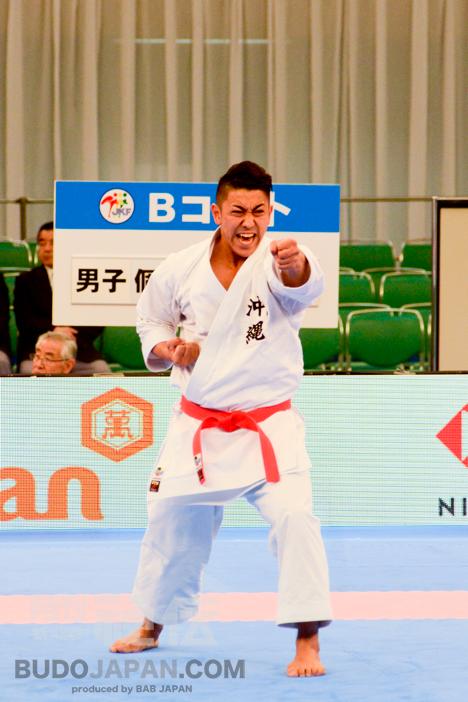
The thing is that the crowd loved it and the judges rewarded it, proving that I am completely out of touch with the requirements of JFK’s brand of karate. And this doesn’t only have to do with the fact that I only did three years of karate 30 years ago: my wanderings along the ways of the martial arts had always been guided by the idea of danger and how to use it to improve both your technique and yourself. In this style of karate danger is pretty much eliminated (bad luck excluded, of course) and the guiding principle seems to be the presentation of a spectacle that comes from the martial arts but has unmistakably deviated significantly from them. Come on: when it was time for the final, everything went dark, the screens started playing a video with fire explosions and the players were literally in spotlights that followed them to the mat!

On the other hand
But there is a but: these people have put in their karate thousands of hours of training –arguably more than a hobbyist “orthodox” karateka who only practices two or three times a week. They have worked exhaustively their kata with their teachers and their coaches and to do that they have delved into the styles their kata come from, even if themselves haven’t practiced the actual style (JKF and its parent organization World Karate Federation have their own dan grades pretty much as there are International Judo Federation dan holders who aren’t necessarily Kodokan dan holders) and they have studied their opponents’ strategy in every detail, both in kata and in kumite, to lay out their own. Yes, they “play” for cups or medals but their preparation is real and you have to look very hard to distinguish it from that of a non-sportive martial artist.
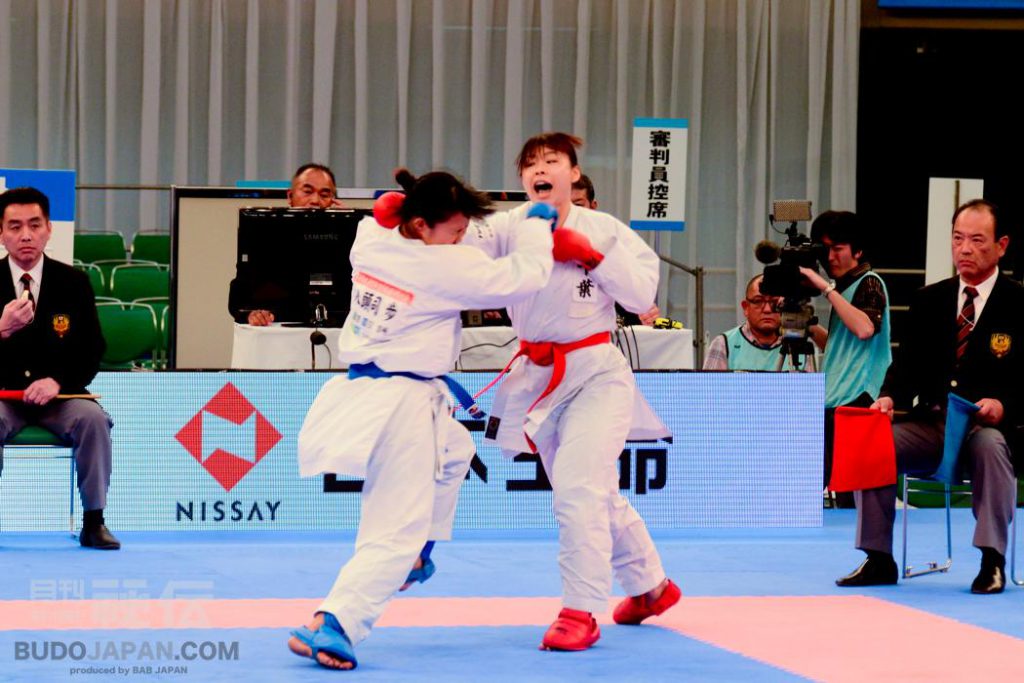
Even the danger is there -at least to some extent: even with protective gear on and even with light contact rules, a jodan kick (and players try for them since they are one of the two things that can give them an ippon) can very easily cause injuries, especially if you are not wearing a helmet -or even if you are: the Greek favorite for the +80kg gold medal in Taekwondo in the 2004 Olympics got knocked out in the final match with what in karate would be called an ushiro geri (back kick) to the face and his helmet couldn’t save him. So yes, maybe these people don’t fight to the death but it would be unfair to say they are just dancing.
Upsides, downsides and hard work
I left the Nippon Budokan steeped in thought. Names like Kiyo Shimizu, Ayumi Uekusa, Ryo Kiyuna or Shoto Federation’s and Teikyo University’s Hideyoshi Kagawa have become household names in Japan and after 2020 and karate’s inclusion in the Olympic Games they will become international stars. Karate is without a doubt the most famous martial art and even though it has seen a temporary loss in popularity mostly because of the Mixed Martial Arts boom of the last 25 years, sport karate is a close enough relative to help it regain its old glory. And when it does, the effect will ripple through the whole martial arts world, pretty much like it did with judo: even sworn enemies of Olympic judo can’t deny its overall positive effect on the martial arts.

So perhaps all the objections I expressed before are just the griping of a grumpy middle-aged man whose chances of ever getting even a first dan in karate are getting slimmer with each passing year. Since the Edo Period, publicity activity to the extent and level of sophistication we’d call “marketing” today was, for better or for worse inextricable part of the martial arts, especially in the big cities and the martial artists who used it to lure students (customers?) weren’t necessarily thought of as “sellouts” neither were their skills considered inferior. As a matter of fact even we, the self-styled “purists” often owe the existence of the arts we practice to the entrepreneurial genius of some Edo Period instructor/businessman so maybe we should get off our high horses and accept both the hard work the Japan Karate Federation and its athletes do and the benefits we directly or indirectly reap from it. They certainly deserve it!

Grigoris Miliaresis has been practicing Japanese martial arts since 1986. He has dan grades in judo, aikido and iaido and has translated in Greek over 30 martial arts’ books including Jigoro Kano’s “Kodokan Judo”, Yagyu Munenori’s “The Life-Giving Sword”, Miyamoto Musashi’s “Book of Five Rings”, Takuan Shoho’s “The Unfettered Mind” and Donn Draeger’s “Martial Arts and Ways of Japan” trilogy. Since 2007 his practice has been exclusively in classic schools: Tenshin Buko-ryu Heiho under Ellis Amdur in Greece and Kent Sorensen in Japan and, since 2016, Ono-ha Itto-ryu under 17th headmaster Sasamori Takemi and 18th headmaster Yabuki Yuji. http://about.me/grigorismiliaresis

Feature Articles
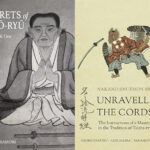
Feature Videos

Wanderings in Budo

- Shinden Fudō Ryū Dakentaijutsu 神傳不動流打拳体術
神傳不動流打拳体術 Shinden Fudō Ryū Dakentaijutsu
Divine Transmission of Immovability School – Striking Body Skill
天之型 Ten no Kata – heaven forms 一拳八相 Ikken Hassō – one fist infinite aspects/changes/potential
日撃 Nichi Geki – solar strike 月肝 Gekkan – moon liver 風靡 Fubi – bowing to the wind, overwhelm 雨龍 Uryū – rain dragon 雲雀 Hibari – cloud sparrow 雪耀 Setsuyaku – snow sparkle 霧散 Musan – fog scattering 霞雷 Karai – mist-thunder
地之型 Chi no Kata – earth forms 秘拳一瞬 Biken Isshun – secret/concealed strike in an instant
理拳 Riken – reason fist 心拳 Shinken – heart fist 雷拳 Raiken – thunder fist 変虚 Henkyo – changing emptiness 一閃 Issen – one flash 把拳 Akuken – grasping/bunching fist 乾坤 Kenkon – sign from heaven, heaven-earth 垂柳 Suiryu – weeping willow
自然至極之型 Shizen Shigoku no Kata – extreme nature – naturally arriving at a conclusion, reaching the end – natural hell methods (when read as Jigoku 地獄)
体流 Tai Nagashi – body flow 拳流 Kobushi Nagashi – fist flow 不抜 Fubatsu – untouchable 両手掛 Ryōte Gake – both-hand suspension 鵲 Kasasagi – magpie 鈴落 Suzu Otoshi – bell drop 霞落 Kasumi Otoshi – mist drop 狼倒 Rōtō – wolf topple 不動 Fudō – immovable 鶉刈 Ugari – quail clip 不諱 Fukan – no posthumous name 自然 Shizen – natural
Share this:
Leave a comment cancel reply.
- Ten Ryaku no Maki 天略の巻
- Chi Ryaku no Maki 地略の巻
- Jin Ryaku no Maki 人略の巻
- Gyokko Ryū Kosshijutsu 玉虎流骨指術
- Kotō Ryū Koppōjutsu 虎倒流骨法術
- Rokushakubō 六尺棒
- Naginata 薙刀 Bisentō 眉尖刀
- Jutte 十手 Tessen 鉄扇 Kodachi 小太刀
- Takagi Yoshin Ryū Jūtaijutsu 高木揚心流柔体術
- Shinden Fudō Ryū Jūtaijutsu 神傳不動流柔体術
- 6-7Apr12 – Yari Ken Taijutsu – Sheffield
- 2011 – summary
- 2010 – summary
- 2009 – summary
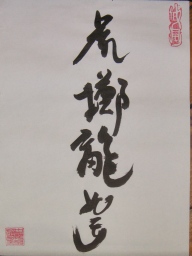
- August 2012
- February 2012
- January 2012
- December 2011
- November 2011
- October 2011
- August 2011
- February 2011
- January 2011
- December 2010
- November 2010
- October 2010
- August 2010
- February 2010
- January 2010
- November 2009
- September 2009
- Bujinkan Reading – Jim Jones
- Fudoshin – Pete Reynolds
- Henka – A local's perspective – Doug Wilson
- Lomax Dojo – Ed Lomax
- Santa Monica – Michael Glenn
- Shizen Gyo Un Sui – Duncan Stewart
- Tazzie Devil – old blog – Duncan Stewart
- Entries feed
- Comments feed
- WordPress.com
Blog at WordPress.com.

- Already have a WordPress.com account? Log in now.
- Subscribe Subscribed
- Copy shortlink
- Report this content
- View post in Reader
- Manage subscriptions
- Collapse this bar

GUIDE TO BUDA-DAVAO TOURIST SPOTS
Let us explore Buda Davao Tourist Spots and visit this little Baguio of the south, known for its cold weather located a 1-hour drive from Davao City. Buda Davao is one of the favorite destinations for most of the Davaoeños and neighboring provinces because of the nature of its cold weather. Visitors will find scenic views of nature which every visitor can appreciate especially the breathtaking views of the mountains. Here we feature some of the most visited places in Buda Davao.

- Where Is Buda-Davao
- How To Go Buda Davao
- Must Visit Places In Buda A. Highway 81 B. Bemwa Farm C. Sonnen Berg Mountain View Resort D. Philippine Eagle Landmark
WHERE IS BUDA-DAVAO
Buda is located in between the Davao region and Bukidnon Province, which is roughly 3,000 feet above sea level.
HOW TO GO BUDA DAVAO
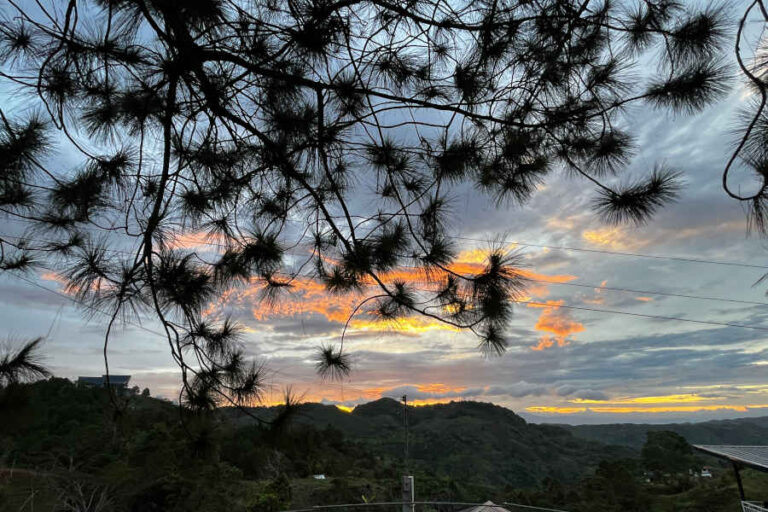
Most of the visitors heading to Buda Davao are taking private transport, it is also highly recommended since most Buda Davao Tourist Spots are in distant places. Visitors can also hire private transport or avail of the travel tour packages to Buda Davao. There are many travel packages, that covers day tour activity and the recommended itinerary.
MUST VISIT PLACES IN BUDA DAVAO

#1 HAVE A BREAK AT HIGHWAY 81

Highway 81 is a one-stop location where visitors can enjoy the relaxing vibe of nature. The place offers an amazing view of the horizon surrounded by high-standing pine trees that gives cold comfort. Highway 81 is a great place to hang out and chill with friends or family together with their famous food combination of “puto” and “sikwate”, visitors can feel the relaxing ambiance of nature. Visitors can also stay overnight in the available cabins and experience the cold weather.
#2 PICK VEGETABLE AT BEMWA FARM

Bemwa Farm offers a vast view of planted vegetables like lettuce and fruits which are planted along the field. The farm offers fresh vegetable salad, fruit drinks, and strawberry jam on sale to the public and visitors can try the strawberry ice cream. Visitors who are into gardening can also check and buy to different sorts of plants. There is no entrance fee when getting into the Bemwa Farm, visitors only need to pay the parking fee of Php 20.00 .
#3 CATCH THE SUNRISE AT SONNEN BERG MOUNTAIN VIEW RESORT
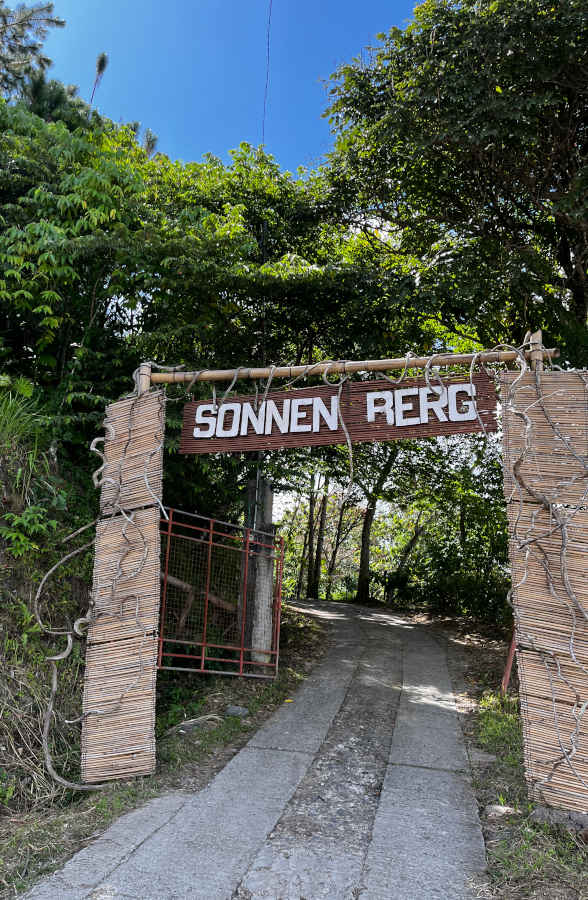
One of the best places to visit in Buda-Davao is the Sonnenberg, which provides a panoramic view of the mountainous area of Davao. Most of the visitors visit Sonnen Berg Mountain View early in the morning to catch the sea of clouds. With the scenic view, visitors can have the feeling of peace of mind while watching the relaxing atmosphere. The entrance to the resort is Php 50.00 , which is consumable depending on the food being ordered. The resort has a restaurant where visitors order food or sip hot chocolate/coffee.
#4 DROP-BY AT PHILIPPINE EAGLE LANDMARK

An iconic landmark when visiting Buda-Davao is the Eagle structure which is erected on the side of the highway. It is the famous stop-over point, where visitors can alight on the side of the road and take a snap of the eagle monument. The eagle monument serves strategic location and boundary where visitors are considered to be within the Davao region. There are also plants, flowers, and some souvenirs which are sold by locals on the side of the monument.
#5 EXPERIENCE THE TREE HOUSE

The Treehouse offers a great place for the family to spend quality time with one another. The house is surrounded by charming views of the trees and mountain hill which makes it a perfect nature ambiance.
FINAL THOUGHTS

Having visited Buda Davao tourist spots, it is the perfect place for people to enjoy and distress. Visitors who want to escape the hustle and busy city life, head to Buda Davao and experience the adventure. The atmosphere is peaceful and calm, and with the abundance of trees, Buda Davao gives alluring beauty to nature. Buda Davao’s weather is cold and windy especially in the late evening and early morning.
Connect with Us
the gees travel
You might also like, ipoh street art & mural lane, 10 best places to visit for free in singapore | 2022, things to do – guyam island siargao philippines, leave a reply cancel reply.
This site uses Akismet to reduce spam. Learn how your comment data is processed .
- Bujinkan Ninjutsu
- Find Us (Map)
- Bujinkan.com
- Huddersfield Kouryuu Dojo
- Edinburgh Kouryuu Dojo
- Wanderings in Budo
- Our Facebook page
- Our Google+ page
Bujinkan 武神館 Glasgow Omou 思う Dojo 道場
Sunday 18:00 to 21:00, email chris for information about bujinkan omou dojo ninjutsu martial arts glasgow.
Situated close to the city centre, we are only 5 minutes walk from St Georges Cross subway station The Griphouse Top Floor, 10 Possil Road, G4 9SY Blue door to left of Tower Bar
Welcome to the Bujinkan Ninjutsu Omou dojo martial arts club in Glasgow, Scotland. We train in the Japanese Martial Art of ninjutsu, headed by grandmaster Dr Massaki Hatsumi. This is a Samuari, as well as a Ninpo art.
Bujinkan Ninjutsu is one of the the most comprehensive martial arts systems available, comprising fitness, unarmed combat and weapons.
We provide a friendly training environment and encourage a community spirit within our club. We try to avoid an overly competitive environment for the safety and enjoyment of all.
The training hall has been in place since 2001 and aims to pass on the teaching of our grandmaster (Soke) Dr Masaaki Hatsumi and the traditions of the 9 martial arts schools that make up the Bujinkan (Ninjutsu).
The Glasgow Omou dojo of the Bujinkan in Britain, is sponsored by the Bujinkan Edinburgh Kouryuu Dojo and Bujinkan Huddersfield Kouryuu Dojo
Copyright © 2001-2016 Bujinkan Omou Dojo Glasgow

IMAGES
VIDEO
COMMENTS
We would like to show you a description here but the site won't allow us.
Wanderings in Budo. musings on a journey along the warrior path . 位取 Kurai dori & Context. 位取 Kurai dori in the simplest sense means to take position. In Kotō ryū the kurai dori can easily be seen as the five kamae - migi seigan, hidari seigan, hira ichimonji, hōkō and bōbi. Kurai dori though is much more than kamae, it means to ...
The original Japanese is 礼に始まり礼に終わる (Rei ni hajimari rei ni owaru). omitting any reference to budo. This phrase is common in Japan, where everything begins and ends with a bow. It's also where we non-Japanese trip over the translation. The "rei" 礼 in "Rei ni hajimari rei ni owaru." is commonly translated as one ...
Budō (武道) is a term that defines modern Japanese martial arts. Bujutsu (武術) is another term that can be defined as the technique or science of war. It's used interchangeably in English with the term "martial arts". "Martial arts", transliterated into Japanese would be kakutōgi (格闘技), which means "fighting skills".
EN. CN. Budo that have been well known in Japan since ancient times include judo, kendo, karate, kyudo, sumo, aikido, shorinji kempo, naginata halberds, and jukendo.They can be experienced at many places across Japan. Introduction of Budo Tourism. Initiatives in Japan. Budo refines your personality, enhances your morality, and respects civility.
Grigoris Miliaresis has been practicing Japanese martial arts since 1986. He has dan grades in judo, aikido and iaido and has translated in Greek over 30 martial arts' books including Jigoro Kano's "Kodokan Judo", Yagyu Munenori's "The Life-Giving Sword", Miyamoto Musashi's "Book of Five Rings", Takuan Shoho's "The ...
Budo, a form of martial arts originated in Japan, is a mixture of sport and culture. As Japan is the birthplace of Budo, you can experience it in various loc...
They are simply overtaken by the "new noise" of daily life. The corollary in Budo is that the very same practice and constant repetition that we use to build our core skills, and then hone them, inevitably draws us away from being alert, in the moment, to their inherent richness. It is possible to intercept the mind's wanderings; not just ...
Wanderings in Budo; ... The Bujinkan or Budo should fit into your life and enhance it, not take it over. The Nine Schools of the Bujinkan as taught by Grandmaster Masaaki Hatsumi: Togakure Ryu Ninpo Happo Hiken - 34th Grandmaster Gyokko Ryu Kosshijutsu Happo Hiken - 28th Grandmaster
BUDO JAPANVideo On DemandProduced by BAB JAPAN from Tokyo. You can easily discover many streaming videos by the greatest Japanese masters, available through Vimeo On Demand (VOD). Click on any title to read a full description, watch a trailer, and purchase. You can watch your purchased video right away!! Karate. Aikido & Jujutsu. Kenjutsu & Iai.
Wanderings in Budo. musings on a journey along the warrior path. Samurai. Japanese Warrior. Katana. Japanese. Samurai Artwork. Japanese Prints. Traditional Japanese Art. Japanese Artwork. Samurai Art. WordPress.com. 3M followers. Comments. No comments yet! Add one to start the conversation. More like this. More like this. Art.
Wanderings in Budo. musings on a journey along the warrior path . Important - to anyone reading and referring to my wanderings. Take note! Please anyone that reads this and the list of kata to the right - it is a summary of my present understanding of my study in the Bujinkan and a practice in kanji. It is NOT a list of all the kata/waza of ...
39K Followers, 492 Following, 327 Posts - AN AUSSIE WANDERING JAPAN & THE WORLD (@ryokanwanderings) on Instagram: " writer @tokyokaleidoscope @yukkurisansou 温泉旅館、ホテル、旅行、体験等のPR承ります 15+yrs • discover lesser known Japan ️ outdoor onsen • ryokans • hotels"
Budō is the idea of formulating propositions, subjecting them to philosophical critique and then following a "path" to realize them. [6] Dō signifies a "way of life". Dō in the Japanese context is an experiential term in the sense that practice (the way of life) is the norm to verify the validity of the discipline cultivated through a given ...
Saved searches Use saved searches to filter your results more quickly
Wanderings in Budo. musings on a journey along the warrior path. Japanese Art. Traditional Japanese. Japanese Culture. Japanese Traditional. Japanese Prints. Traditional Japanese Art. Japanese Woodcut. Japan. Japan Art. WordPress.com. 3M followers. Comments. No comments yet! Add one to start the conversation. More like this.
About the author. Grigoris Miliaresis has been practicing Japanese martial arts since 1986.He has dan grades in judo, aikido and iaido and has translated in Greek over 30 martial arts' books including Jigoro Kano's "Kodokan Judo", Yagyu Munenori's "The Life-Giving Sword", Miyamoto Musashi's "Book of Five Rings", Takuan Shoho's "The Unfettered Mind" and Donn Draeger ...
拳流 Kobushi Nagashi - fist flow. 不抜 Fubatsu - untouchable. 両手掛 Ryōte Gake - both-hand suspension. 鵲 Kasasagi - magpie. 鈴落 Suzu Otoshi - bell drop. 霞落 Kasumi Otoshi - mist drop. 狼倒 Rōtō - wolf topple. 不動 Fudō - immovable. 鶉刈 Ugari - quail clip.
A JAPAN TRAVEL BLOG showcasing Japanese onsen ryokans in off the beaten path to popular locations; from the affordable to luxury, the traditional to the modern; with rooms that have outdoor private onsen, delicious traditional Japanese kaiseki dinners & remote, stunning nature. Plus Japan travels to lesser known prefectures - sharing the real ...
One of the best places to visit in Buda-Davao is the Sonnenberg, which provides a panoramic view of the mountainous area of Davao. Most of the visitors visit Sonnen Berg Mountain View early in the morning to catch the sea of clouds. With the scenic view, visitors can have the feeling of peace of mind while watching the relaxing atmosphere.
New York Budo Association, New York, New York. 1,918 likes · 144 talking about this · 371 were here. Japanese Budo School Ryushin Shouchi Ryu (柳心照智流) Iaido, Kyudo - Heki-ryū Chikurin-ha (竹林派).
Sunday 18:00 to 21:00. Welcome to the Bujinkan Ninjutsu Omou dojo martial arts club in Glasgow, Scotland. We train in the Japanese Martial Art of ninjutsu, headed by grandmaster Dr Massaki Hatsumi. This is a Samuari, as well as a Ninpo art. Bujinkan Ninjutsu is one of the the most comprehensive martial arts systems available, comprising fitness ...